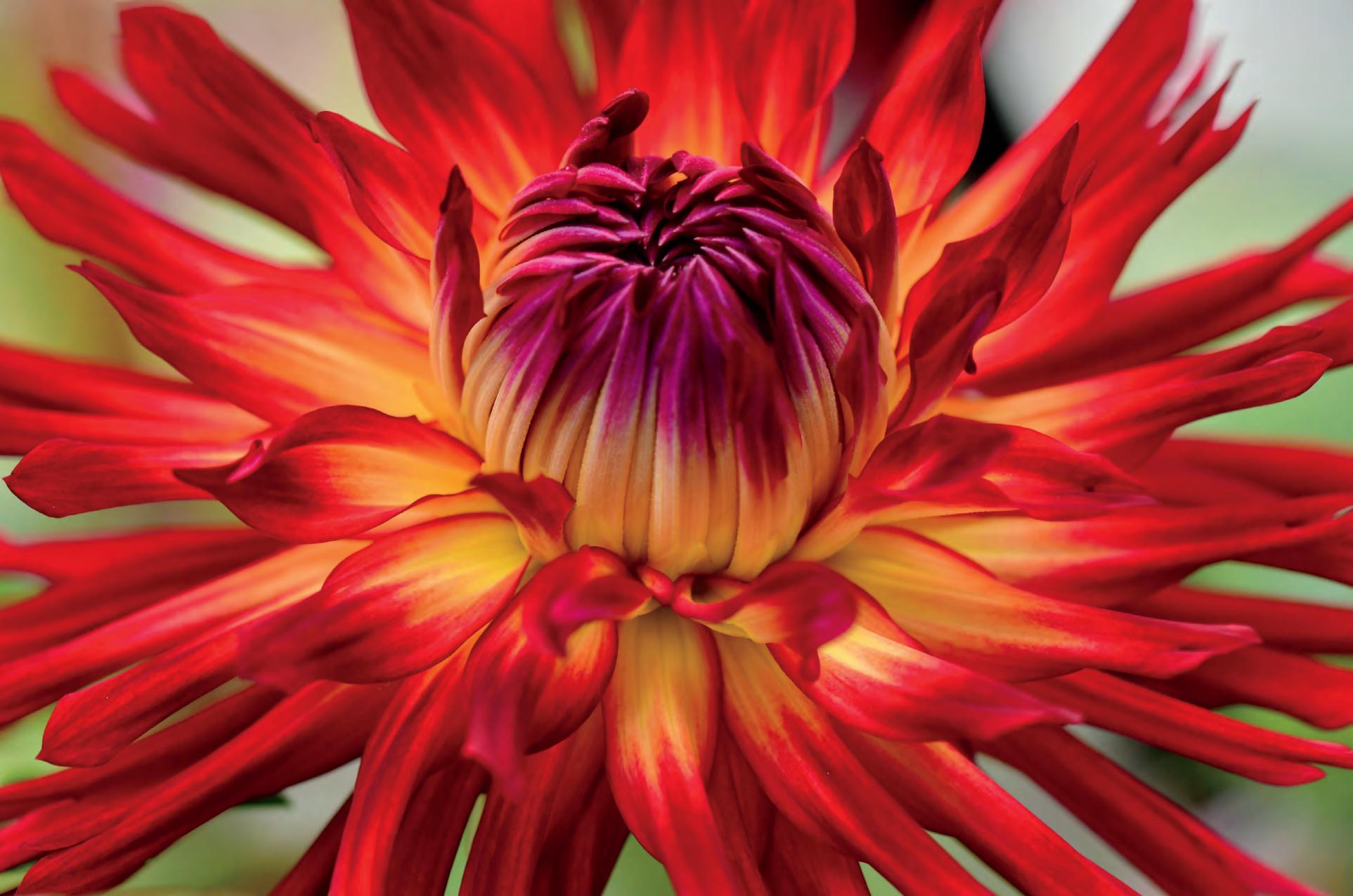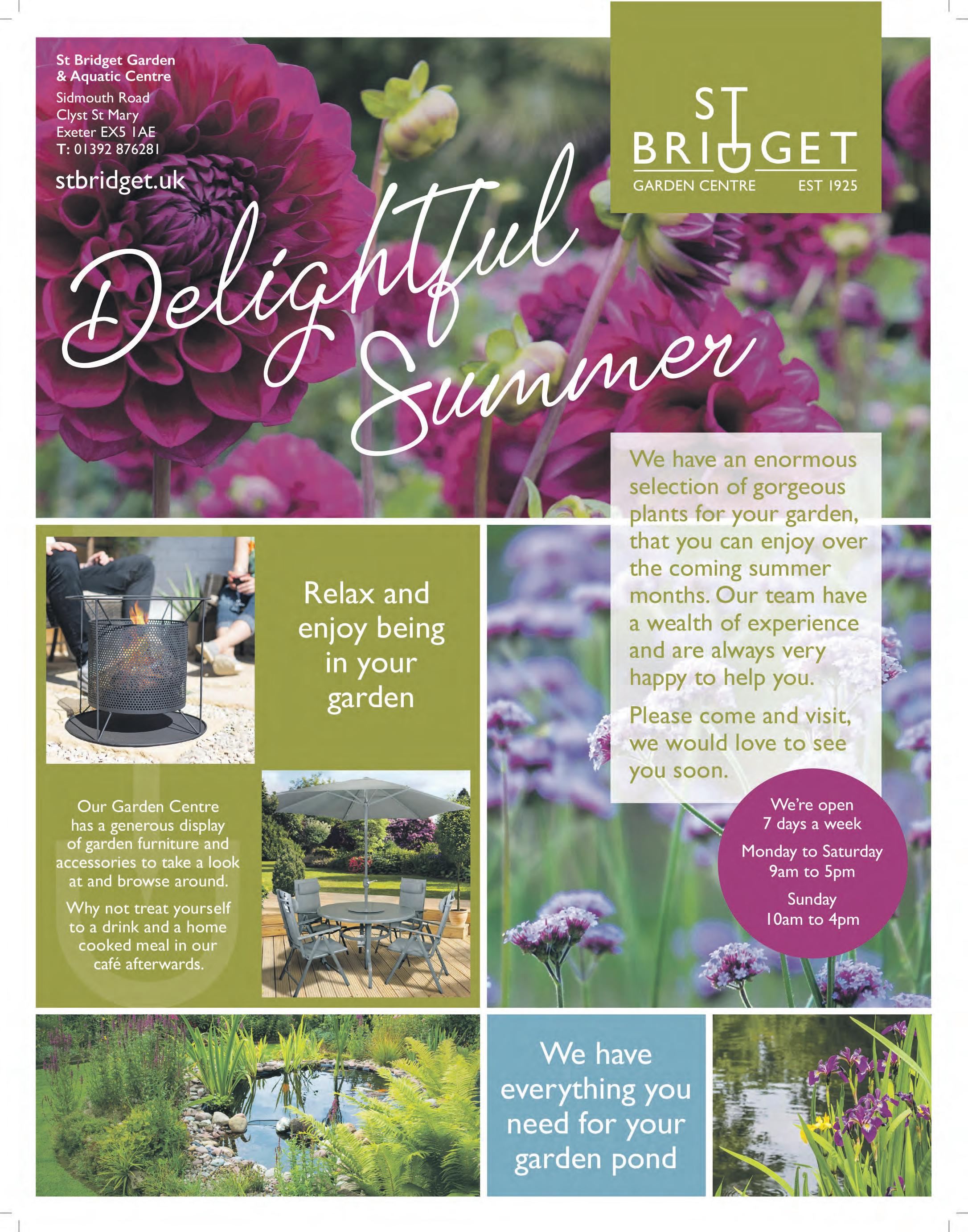









The beautiful hillside gardens at historic Fursdon House will open for Hospiscare on Wednesday 31st July, from 2pm until 5pm.
The peaceful gardens have wonderful views across the parkland towards Dartmoor. Sheltered by the house, hedges and cob walls, are terraces of roses, herbs and perennials in mixed traditional and contemporary planting. There’s a lovely woodland walk, with seasonal wild flowers and pond in the meadow garden.
Fursdon House, home of the Fursdon family for over 765 years, is also open for guided tours and home-made teas, served in its historic Coach Hall tearoom. Admission to the gardens is £6 and £1 for 5 to 16 year olds and to see the house and garden £12, 5s-to 16s £3. There’s an on-site car park with overflow, ramp access to the tearoom for wheelchairs, but wheelchair access is limited in the gardens. Dogs allowed on short leads. Fursdon House, Cadbury, Exeter EX5 5JS.
With over 65 years of experience, Bernaville Nurseries has been guiding customers in perfecting their hanging baskets to bloom all summer long. Crucially, selecting suitable flowers for the basket’s placement is vital for their prosperity.
Opt for a tall, upright plant like an upright geranium or fuchsia for the central or rear position, complemented by fillers such as brachyscome and petunia, with trailing varieties adorning the edges. Bernaville recommends the following favourite trailing plants that elegantly cascade over the sides:
CALIBRACHOA – previously known as million bells or mini petunia, it creates a stunning draping effect.
BACOPA – this creeping herb with delicate flowers adds a charming touch.
IVY GERANIUM – a timeless choice that tolerates partial shade, perfect for shadier areas of the basket.
ILLUMINATION BEGONIA – with vibrant colours and a prolonged flowering period, it’s a delightful addition to any basket.
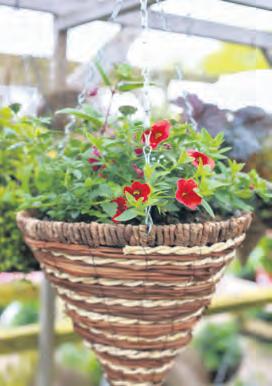
Maintaining these baskets is simple. Ensure regular watering, even as little as one mug’s worth per day during sunnier months, and bi-weekly feeding with an organic fertiliser. From modest beginnings, these plants will flourish, offering an array of blooms and foliage throughout the summer.
For more information visit Bernaville Nurseries and speak to one of their friendly staff who can help you build the perfect basket.
Bernaville Nurseries, 3 Horse Shoes, Cowley, Exeter EX5 5EU Tel: 01392 851326 www.bernaville.co.uk

The wildlife charity, Butterfly Conservation, is expecting record numbers of gardeners and supporters to put some time aside over the next few weeks for the highly anticipated Big Butterfly Count, which will take place from Friday 12th July to Sunday 4th August. The annual programme attracts tens of thousands of people out into their garden, local green space or the countryside to spend 15 minutes counting butterflies and helping to inform conservation action. Hot on the heels of scientific evidence that proves
“A world without tomatoes is like a string quartet without violins.” - Laurie Colwin
“The hum of bees is the voice of the garden.” - Elizabeth Lawrence
Do you have a water-thirsty hose lurking in your shed? Hoses and sprinklers use about 1,000 litres of water an hour* and much of this water is wasted on parts of the garden that don’t need it.
What’s even worse, using a hose can backfire on the wellmeaning gardener. Water a plant and you’re doing exactly that. Spray all around the plant and you’re creating nice moist conditions for weeds to grow around your plant. The advice comes from south west based Waterwise, the leading independent voice in the UK for using water wisely for the benefit of people and the planet.
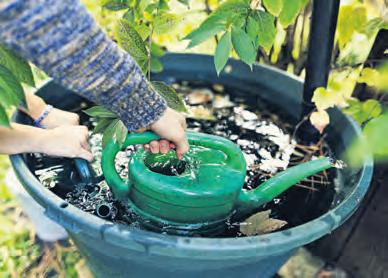
Put the hosepipe down and grab a watering can. It takes a bit longer, but you’ll waste a lot less water, targeting only the areas that need watering.
And wasting less water means saving money on your bills –you’ll be helping preserve water for nature and keeping your bank balance a bit healthier too. You can even get a water butt and collect FREE rainwater!
You can also save water by not watering your lawn in a heatwave, yes it will go brown, but it’ll recover just fine the next time it rains.
Why do we need to save water – it’s been raining loads?
It’s true that the wet winter has meant our reservoir levels are healthy, but another important reason to save water is the energy used to clean and pump water to your tap. Every drop has a carbon footprint and it all adds up. The less water you use, the less energy we use in our treatment works and pumping stations.
Every drip we stop and every drop you save helps tackle climate change, protect our rivers, reduce bills and keep your water flowing. Together we can make a big difference!
*Source waterwise.org.uk
For more water saving tips visit: bristolwater.co.uk/every-drop
counting butterflies is good for your mental health and wellbeing, reducing anxiety by almost ten per-cent, the charity is calling on people to get out for the Count this summer.
Butterflies are indicators of a healthy natural environment, and with half of Britain’s butterfly species already threatened or near threatened with extinction, it’s never been more important to understand how our insects are responding to the changing climate and to take action to protect them. Last year more than 135,000 counts took place up and down the country. For more information and to take part simply visit www.bigbutterflycount.org or download the free Big Butterfly Count app.
Historic Fursdon House A Swallowtail butterfly
Your local Otter Garden Centres:
OTTERY ST MARY Gosford Road, Ottery St Mary, EX11 1LZ
PLYMOUTH Chittleburn Hill, Brixton, Plymouth, PL8 2BH
JACK’S PATCH Newton Road, Bishopsteignton, Teignmouth, TQ14 9PN
TORBAY Moles Lane, Paignton, TQ3 1SY
Also find us at TAUNTON, WINCANTON & LYMINGTON
www.ottergardencentres.com

Visitors to RHS Garden Rosemoor still have the first two full weeks of July to enjoy the annual Festival of Roses in the gardens which remains open until Sunday, 14th July. The gardens host one of the largest collections of roses in the UK, home to more than 200 varieties and over 2,000 specimens in breathtaking displays which has already attracted visitors from far afield.
Ranging from traditional cottage garden climbers to modern varieties, the roses are planted in different settings and combinations in the heart of the garden.
The vast collection even includes cultivars classified as ‘endangered’ and ‘vulnerable,’ so it’s well worth a visit.
You can also join one of the weekly tours every Tuesday at 12pm throughout the festival to learn more about these beautiful blooms or a general garden tour starting at 11am every day (places allocated on a first-comefirst-served basis).
You can also speak to the friendly RHS Advisory team every Thursday to get expert advice on how to care for your own roses at home.
Another Rosemoor event which is still running is the sculpture exhibition involving the works of British sculptor Paul Harvey, inspired by his love of birds and Art Deco design, set in the beautiful Cool Garden and designed by Chelsea Gold Medallist Jo Thompson. It runs through to 1st September. Ticket information and opening times available at www.rhs.org/gardens/rosemoor
RHS Garden Rosemoor, Torrington EX38 8PH
There’s the opportunity to experience the celebration of rural Devon with entertainment of food, shopping, music, horticulture and farm life at the Mid Devon Show on Saturday, 24th July, a show which has a strong gardening theme.
It’s a one day show open from 8.30 am to 6.30pm so there’s a lot for visitors to pack in.
The show’s flower and garden marquee is a wonderful part of the event, always well supported by local traders and exhibitors together with the popular show classes.
The marquee is a must-see for anyone with a love for gardening or just appreciating beautiful flowers. There will be a variety of stalls selling plants and gardening equipment so you can take a little bit of the show home with you.
Mid Devon Show, Knighthayes, Tiverton, Devon EX16 7PP
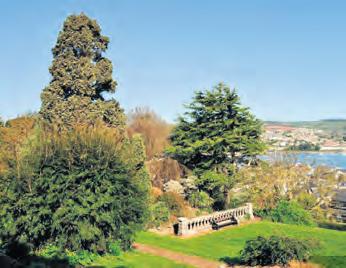
The 133rd Honiton Agricultural Show takes place on Thursday, 1st August and will again reflect a traditional agricultural show in the heart of the east Devon countryside.
The Devon show is one of the largest in the country and a showcase for the best of local farming, produce, crafts and rural skills. It is a great family day out and again the show will feature plenty of activities, demonstrations, livestock and entertainment with over 400 trade exhibitors.
Dogs are allowed on retractable leads but are not allowed in the Food Hall or within the Cattle Lines. Mobility scooters are available. Adult tickets £18 in advance, £20 on the day. All car parking is free.
Honiton Showground, Buckerell, Honiton, Devon EX14 3EW www.honitonshow.co.uk

Two beautiful gardens at contrasting Devon properties are opening for the National Garden Scheme in July, raising much needed funds for nursing and caring charities.
LITTLE ASH BUNGALOW Fenny Bridges Honiton EX14 3BL opens for the NGS on Sunday, 21st July from 1pm until 5pm, a large garden of one and a half acres packed with different and unusual bulbs, herbaceous perennials, trees, and shrubs, naturalistic planting in colour coordinated mixed borders, highlighted by metal sculptures, stream, pond and damp woodland area, mini-wildlife meadows and raised gravel/alpine garden. Admission is £5, children free, with homemade teas available, plants for sale, wheelchair access, dogs on short leads allowed and coaches welcome. Group visits of ten and more for the NGS by arrangement are also available, go to ww.ngs.org.uk for details.
BICKHAM HOUSE, Kenn, Exeter, Devon, EX6 7XL opens for the NGS on Sunday, 21st July - six acres with lawns, borders, mature trees, formal parterre with lily pond, walled garden with a colourful profusion of vegetables and flowers, and a palm tree avenue leading to a millennium summerhouse, late summer colour with dahlias, crocosmia and agapanthus, cactus and succulent greenhouse, pelargonium collection and lakeside walk. Admission £5, children free, open 1.30pm to 5pm each open day. Homemade teas available, plants for sale, wheelchair access, dogs allowed on short leads, picnics welcome, also coaches. This is another garden that opens for the NGS by arrangement, details on the NGS website as above. Bickham House is also open for the NGS on Sundays 4th and 18th August, and 8th September.
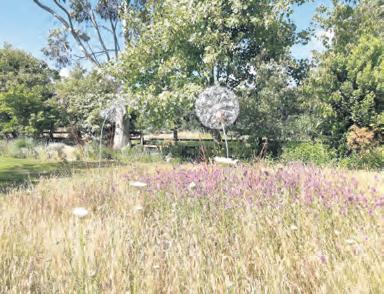
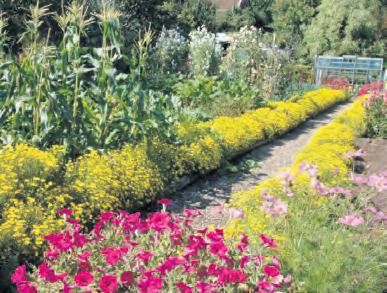
For more open gardens in Devon and other areas covered by Country Gardener go to page 30
Homeyards Botanical Garden, once upon a time private garden, but now belonging to Teignbridge District Council, is open to the public free of charge seven days a week. Located on a sloping hillside above the seaside village of Shaldon, the gardens have stunning views of the Teign estuary and across Lyme Bay towards Dorset. The arboretum includes some striking trees and features such as the castle folly, the Burma Star rose garden, a pond and rill and an Italianate garden make the Gardens an interesting place to explore.
Homeyards Botanical Garden has consistently been awarded a Green Flag. It is tended by a part-time gardener and Friends group volunteers regularly work to maintain this public garden. The castle hosts community events and Friends volunteers open it for refreshments; during the warmer It can be hired from Teignbridge for private parties. Homeyards is a steeply sloping site. Four of the five pedestrian entrances incorporate steep steps. The pergola entrance at the eastern end of the gardens (Horse Lane) is the most accessible for prams and wheelchairs.
Homeyards Botanical Garden Torquay Rd, Shaldon, Teignmouth TQ14 0BD
Woolacombe’s wild flowers now in full glory
Visitors to Woolacombe Down in North Devon can experience how the area has been transformed as wildflower meadows come alive this summer.
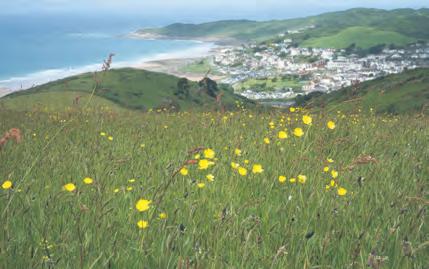
Thanks to the National Trust’s North Devon Grasslands project, 154 hectares of species rich grassland have been created across north Devon since 2022, helping to combat the decline in the UK’s wildflower rich grassland. Visitors can enjoy these wildflowers looking their best while walking on Woolacombe Down through mid-July and later, depending on the weather.
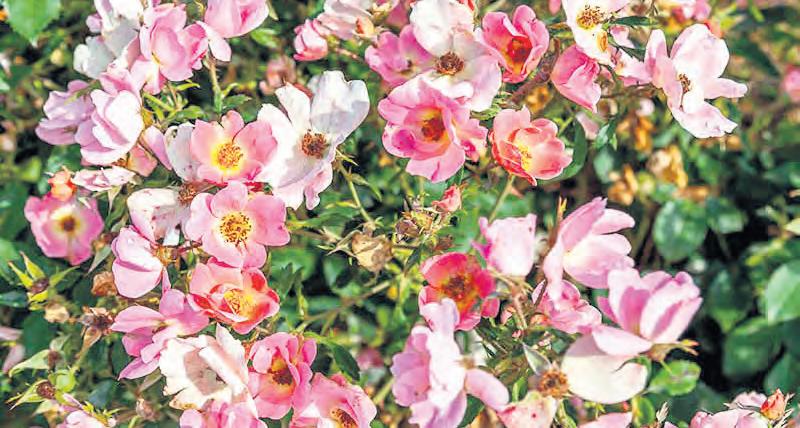
Plant breeders have taken the natural simplicity of the wild rose and combined it with a long and prolific flowering season, disease resistance and new colours to create single rose sensations. The modest blooms of single-flowered roses have a simplicity and perfection all of their own, and are highly attractive to pollinators.
It is wonderful to grow roses in all their infinite forms and shapes but the natural-looking, single (as opposed to the more blowsy double) cultivars are a particular favourite. All roses originally had a single-flowered parentage, and are found across the northern temperate and subtropical world. The pale-blush flowers of the native dog rose (Rosa canina), for example, which decorate the hedgerows in June, are simple yet exquisitely beautiful. They may be fleeting, but perhaps because of this we tend to appreciate their delicate beauty more sincerely.
A wonderful trait of single roses is the way they shed their petals, and in doing so, eliminate the need for deadheading. This is greatly appreciated with the taller climbing and rambling forms where the task is incredibly inconvenient, if not impossible. The petals may also change colour and give a pleasing, two-tone effect before shattering, as with Rosa ‘Francis E Lester’, whose petals fade to white with age. As with cherry blossom, so too the fallen petals from the floriferous, single ramblers eventually become petal confetti, concluding the flower display with a beautiful, thick carpet of white.
Single-flowered roses are more hospitable for bees and other pollinating insects than the double forms, where the nectar and pollen – if present at all – can be difficult for the insects to access. Having viable flowers also increases the likelihood of rosehip production, the fruits often having ornamental value of their own. Discover the best roses for hips. Having fewer petals per flower may also mean more flowers at a time and for a longer period.



Nowadays there is quite a large selection of single-flowered roses to choose from and they can be found across all sections of the genus Rosa. Indeed, some of the cultivars included here might be classified as semi- double by aficionados. However, the lines are fairly blurred because they look, to all intents and purposes, like singles.
In the right conditions, roses can be very long-lived plants, and can even become coveted heirlooms, passed from one generation of gardener to the next. When planting a new rose, it is important to remember that it needs a chance to find its feet. Plants will often take a few years to build up a good foundation of roots before they show signs of vigour above ground and begin producing quantities of new wood and flower.
Roses are normally bought and planted in winter, when they are dormant and bareroot, or at any time of the year as a container plant (although an early winter planting is best for all but the most tender types).
It is vital when planting to add compost to the planting hole and mix it properly with the surrounding soil. Make the hole ample enough to sensibly accommodate the roots without having to bend them to position the plant at proper depth. Firm the soil around the roots so the plant does not rock or sit too wet. During this formative period, it is important the rose is given space to breathe and is not swamped by neighbouring plants. Once established, the strong, forked rose roots are extremely competitive against those of other plants.
ROSA ‘DORTMUND’ produces large, red flowers with a conspicuous white eye in succession throughout the summer – they are so big it takes only a few to make an impression. It can be grown as a climber or shrub – for instance growing it through a golden yew.
This Rosa moyesii hybrid is a large shrub with catchy, red flowers that have a central, green-eyed, gold stamen boss. Blooms appear in early summer on arching stems, followed by decorative, flask-shaped, orange-red hips. Remove old-flowered wood in late winter to maintain vigour.
ROSA ‘MEG’ - a charming climber with large, flat, semi-double flowers in flamingo pink, each bloom with an apricot-yellow eye and conspicuous red stamens. Scented flowers in June are followed by large, fat, dark-ginger hips that persist all winter. Good for cutting, but prone to blackspot. 3m.
A charming climbing rose with large, flat, semi-double flowers in flamingo pink, each bloom with an apricot-yellow eye and conspicuous red stamens. Scented flowers in June are followed by large, fat, dark-ginger hips that persist all winter. Good for cutting, but prone to blackspot. Height: 3m.
ROSA ‘SUMMER BREEZE’ - an easy-to-grow rose that throws hot-pink, mediumsized flowers all summer atop a foil of apple-green foliage. It can be trained against a wall or grown up through a small tree. Prune the oldest wood in late winter to encourage vigour. 4m.
An easy-to-grow climber that throws hot-pink, medium-sized flowers all summer atop a foil of apple-green foliage. It can be trained against a wall or grown up through a small tree. Prune the oldest wood in late winter to encourage vigour.
ROSA ‘GERANIUM’. This R moyesii hybrid makes a large shrub with catchy, red flowers that have a central, green-eyed, gold stamen boss. Blooms appear in early summer on arching stems, followed by decorative, flask-shaped, orange-red hips. Remove old-flowered wood in late winter to maintain vigour

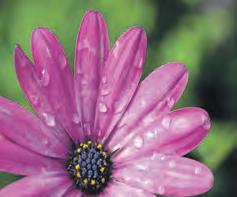


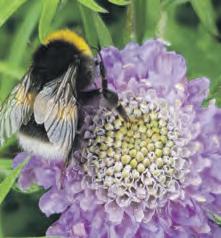
Loddiswell Kingsbridge Devon TQ7 4DD www.avonmill.com 01548 550338 Lovely Café serving Fabulous Breakfasts, Lunches & Devon Cream Teas
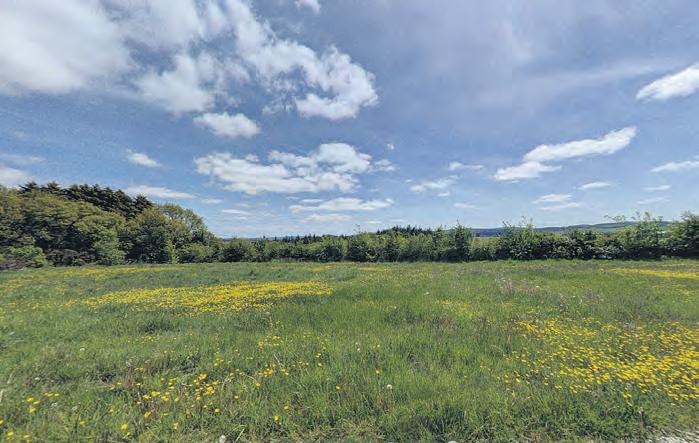
Fine Turf (Devon) Ltd, a family run business established a locally seeded turf, suitable for a variety of gardens, which treated and fertilised several times throughout the growing
We provide a natural burial site for all faiths and beliefs in the countryside overlooking Dartmoor.
We also supply topsoil, composts and landscaping bark for all your gardening needs, we can mix these for your requirements for planting flowerbeds and vegetable plots. All our topsoil is certified and stored dry all year round, as are the composts.


WE SUPPLY LOCALLY SEEDED TURF, TOPSOIL, COMPOSTS (MUSHROOM/ORGANIC GREEN WASTE) AND LANDSCAPING BARK, WHICH WE CAN DELIVER OR YOU ARE WELCOME TO COLLECT.
Lower Waye Farm, Ashburton TQ13 7ET

Lower Waye Farm, Ashburton TQ13 7ET TEL: 01364 652538
EMAIL: fineturfdevon@gmail.com
WEBSITE: turfdevon.co.uk
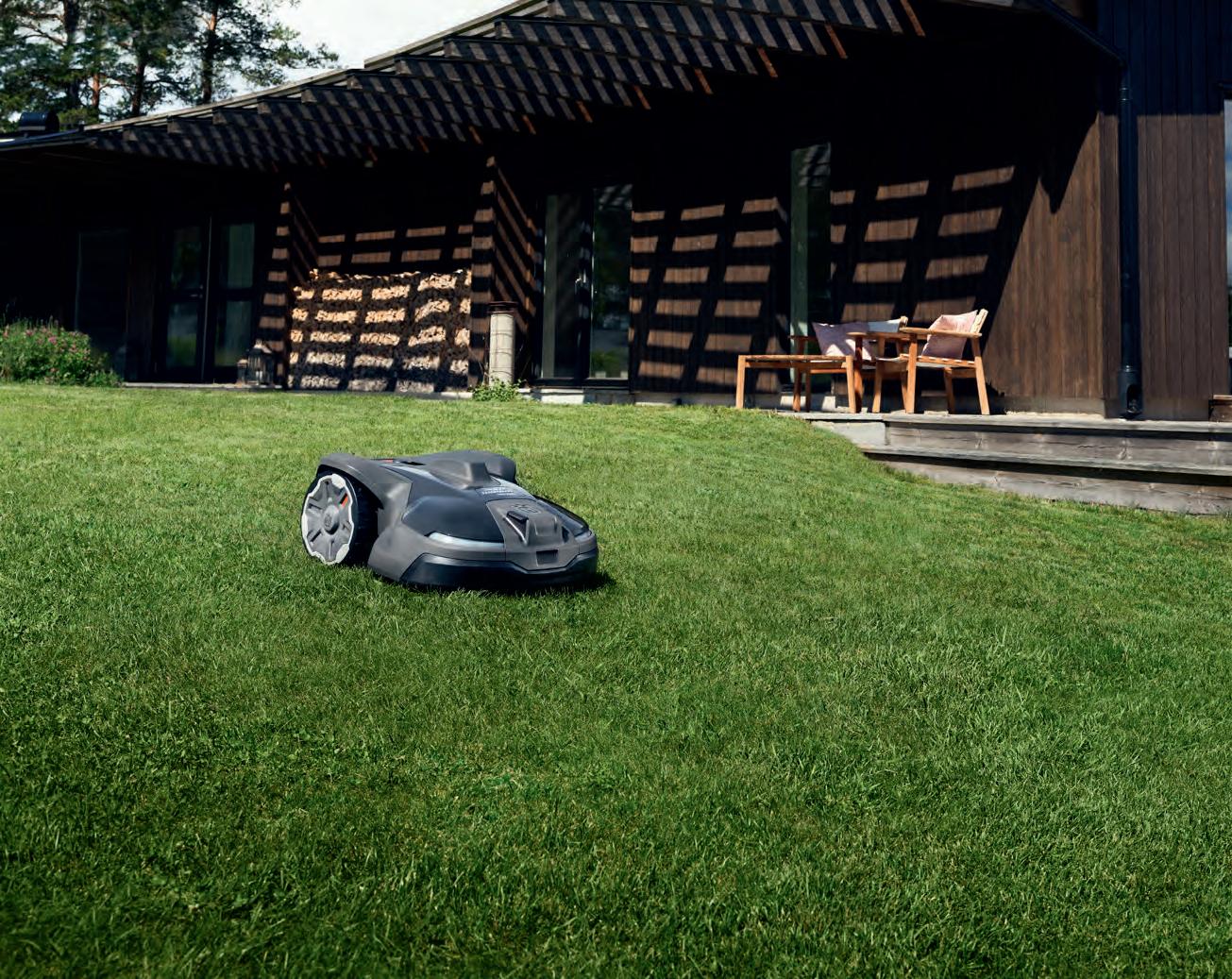





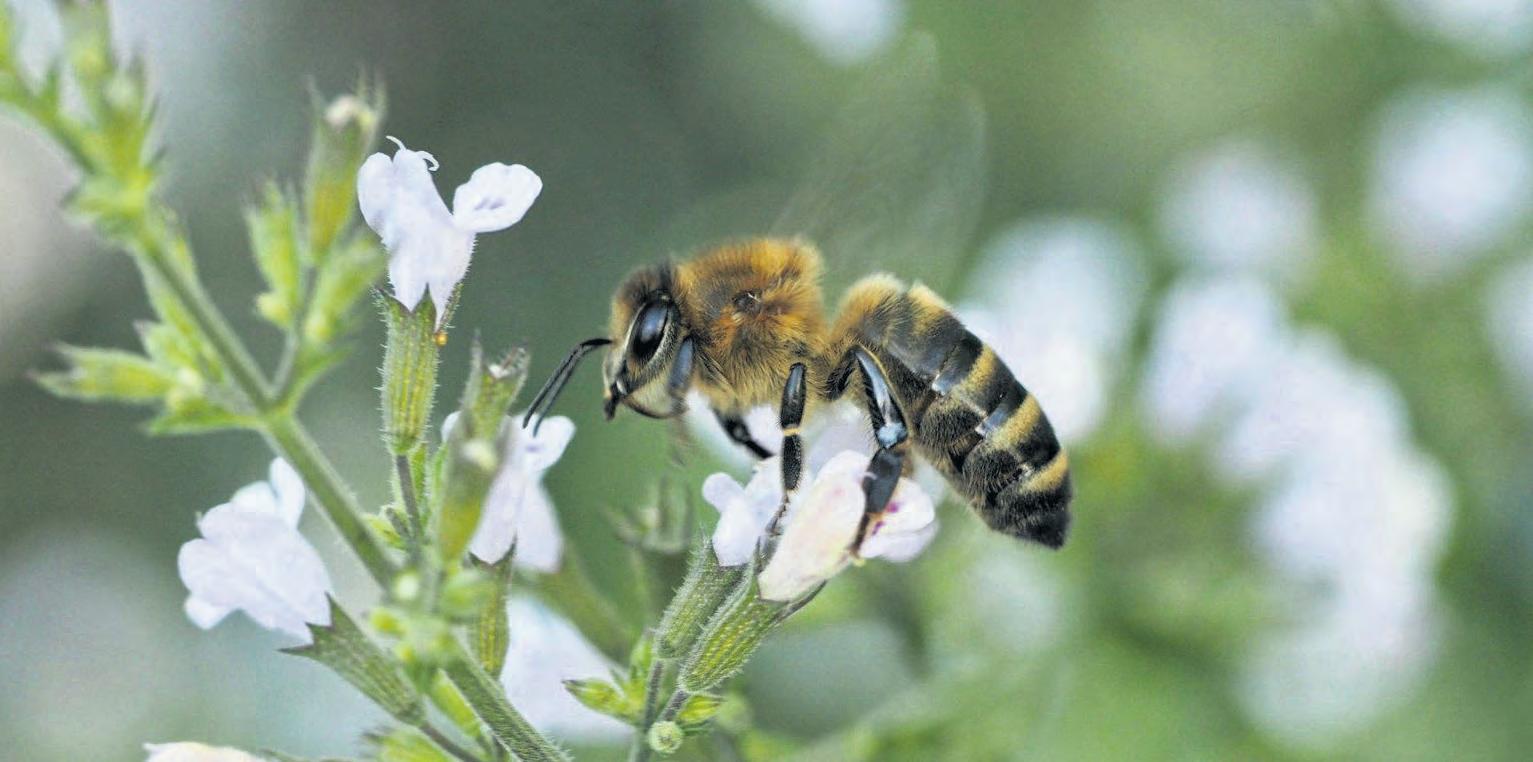
Bees have a vital role to play in our food chain. Not only do they pollinate the fruits and vegetables we eat, but they also pollinate the clover and alfalfa consumed by dairy and market animals. Due to the loss of habitat and use of pesticides though, there is a worldwide decline in bee populations.
Planting nectar-rich flowers is one way to help bees and you don’t need wide open spaces to do this. Anyone with an outside balcony or patio space can grow container plants for bees.
How to grow a potted bee garden
Growing a container pollinator garden is not difficult. If you’re familiar with any type of container gardening, cultivating a bee garden in pots is as simple as switching to pollinator friendly container plants. If this is your first experience with container gardening, follow these steps to create a potted bee garden:
• Choose a planter or two – The bigger the pot, the bigger the price tag. Don’t let that discourage you from purchasing a large planter though. Evaporation and nutrient exhaustion are inversely related to planter size. Novice gardeners may find success with one big planter than with several small flowerpots.
• Provide adequate drainage – Excess moisture leads to root rot and disease. If your planter didn’t come with drainage holes, use a sharp knife or drill to make several holes in the bottom of the pot.
• Use quality potting soil – Purchase bags of commercial flower potting soil to provide the nutrients your pollinator-friendly container plants need to grow strong and bloom vigorously.
• Choose nectar-rich varieties of flowers – Select several types of flowers which bloom at different times so your potted bee garden will provide season-long nectar for the bees. Use the below list for suggested pollinator friendly container plants.
• Carefully plant your bee garden in pots or containers
– Begin by placing newspaper, coir liners, or landscape fabric in the bottom of the planter to prevent soil from escaping. Some gardeners prefer to add a layer of gravel or charcoal to the bottom of the pot. Next, fill the planter to within four to six inches (ten-15 cm.) from the top with potting soil. Place the plants according to mature height with taller plants in the back or middle of the container. Top off the planter with potting soil and water regularly.
• Place the container pollinator garden in full sun –Bees prefer to feed in direct sunlight. Try locating the planter where it will receive at least six hours of morning or evening sun per day. A spot with afternoon shade and a wind block will make it easier to maintain your bee garden in pots.
The influential Chelsea Flower Show saw the continuation of one of the gardening themes of the last year or sothat anyone with an outside balcony or patio can plant bee-friendly flowers - it doesn’t take a big garden to help
Why planting containers like this has become such an issue
Unfortunately, the story of bumblebees in the UK over the past century has been one of decline. Two species became extinct and eight (one third) of our remaining 24 species are currently listed as conservation priority species due to large-scale declines in their distribution.
How are bumblebees doing in the UK?
The UK is currently home to 24 species of bumblebee. Two bumblebee species have become extinct in the last century. A further eight bumblebee species are currently listed as conservation priority species due to large-scale declines.
One of our rarest bumblebees, the Great Yellow bumblebee (Bombus distinguendus) is now only found in the far north and west of Scotland and perhaps the rarest UK bumblebee species, the Shrill carder bee (Bombus sylvarum) is found only in a handful of locations in south Wales and southern England.
The UK has lost 97 per cent of wildflower meadows in the last century. Bumblebees are struggling to find enough food and good nesting spots to survive. Habitat loss comes in several forms:
• Outright loss – for example building new houses on a meadow.
• Fragmentation – habitats are becoming cut off from each other.
• Reduced quality – without flowers, gardens, greenspaces and the wider countryside offer little food for bumblebees.
• Increased competition – too many honeybees and commercially reared bumblebees increase competition for food and can lead to the spread of diseases.
Insecticides can directly kill or affect the ability of bumblebees to find food and reproduce. Herbicides kill the flowering plants which are a vital food source for bumblebees.
Shifts in seasonal patterns and weather could disrupt bumblebee behaviour and impact survival at key life stages, such as spring emergence, nesting, and winter hibernation.
Extreme weather events like floods, droughts and storms can have an immediate impact on bumblebees. Floods can drown hibernating queens and underground nests. Droughts can cause plants to wither and die which reduces the amount of nectar and pollen available for bumblebees to feed on and collect for their nest. Storms prevent bumblebees from foraging for food as they struggle to fly in wet, windy weather.
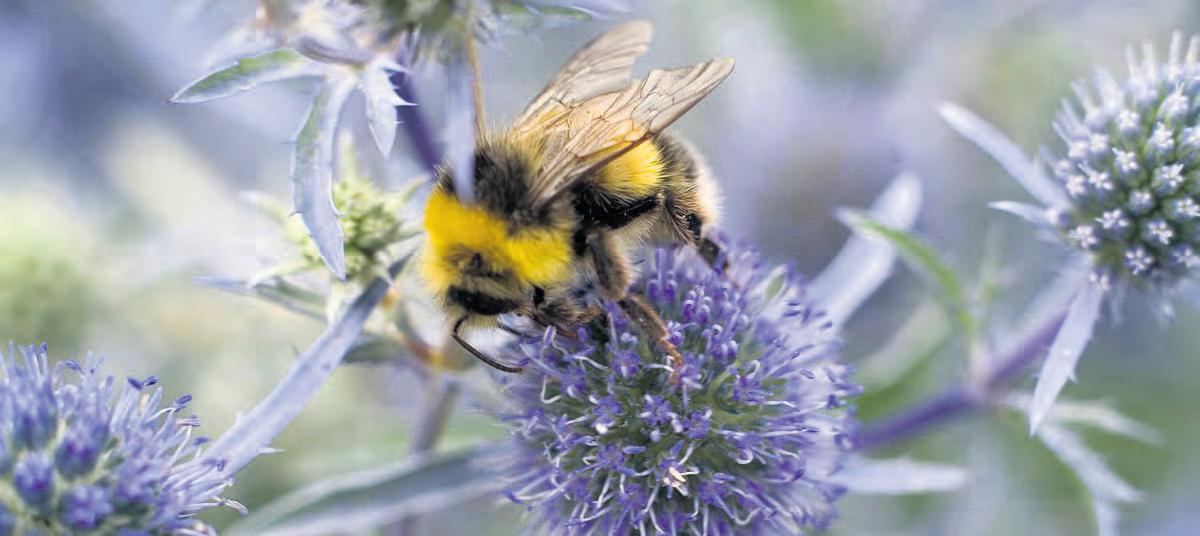
Bumblebees are struggling to find enough food without help from gardeners




“Picked up a copy of your September issue yesterday. I have to say that it was easily the best free magazine of its type I have ever read. Congratulations on such a great publication.”

“I had the opportunity of reading it from cover to cover. It’s a real gem and I look forward to every issue. Thanks to all your team for their input and what must be one of the best magazines around.”




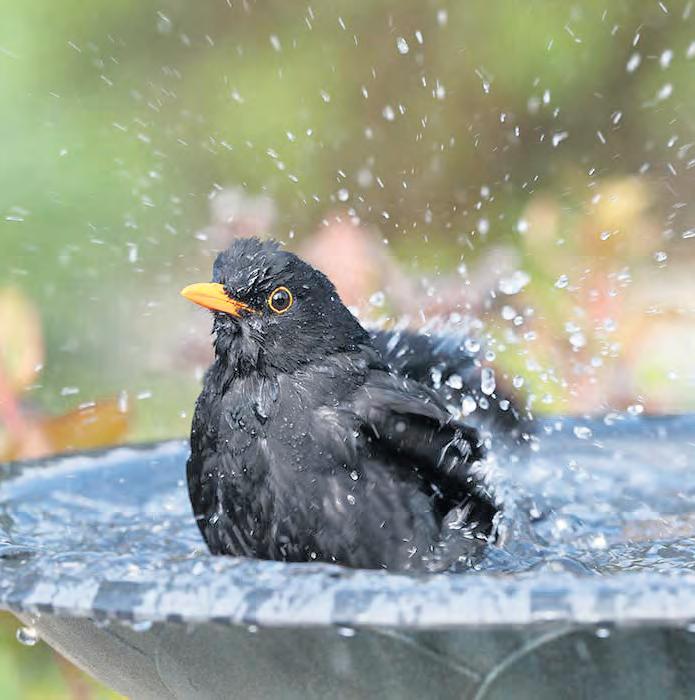
There are many ways we can attract wildlife to our outside spaces, from not mowing our lawns as much, to growing butterfly-friendly plants. But when it comes to our feathered friends, sometimes our best intentions can accidentally lead to bird-feeding mistakes –from using the wrong food to not cleaning their feeders.
As we head into high summer there’s the chance to listen to the advice and see what really are the best ways to feed birds in your garden safely.
First the good news. Lots of us are probably making some basic errors throughout the year when it comes to feeling birds but there are simple ways you can make your garden a safer place for birds.
Dirty feeders cause disease to spread.
A sign of trichomonosis in some birds is matted plumage and uneaten food around their beak. Findings from the RSPB Big Garden Birdwatch reveal that a parasitic disease called trichomonosis is decimating our bird population. Bird food, feeders and drinking water in our gardens are contaminated with this disease. Birds badly affected by it, such as greenfinches and chaffinches, are in decline as a result. There are things we can do to combat it. Remember to clean your feeding stations regularly, as this is something that is often overlooked as many parasites thrive on filthy feeders, including trichomonosis. So, feeders need to be cleaned to ensure that bacteria doesn’t mount up and make our birds sick.
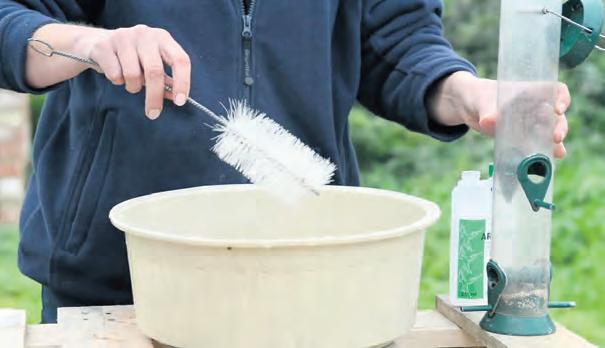
Try to clean bird feeders once a week. Use a mild antibacterial cleaner, such as washing-up liquid, and nothing as harsh as bleachbased products.There are some purposemade cleaners out there too. Save
cleaning equipment to use just for this job and do it outside where possible – anything you can do to make the process as hygienic as possible.
The RSPB also advises that if you see sick birds where you are feeding, temporarily stop feeding for at least two weeks and leave bird baths dry.

Little and often is the best regime to work to.
If your bird feeders are very busy, then you can fill them up more often.
Another way to reduce the risk of bird disease spreading is eliminating the build-up of food waste. The issue around overfilling is that food can go off, particularly in hot or wet weather. You don’t want to put out vast amounts unless you know your garden birds are going to eat it all quickly.
When birds need lots of energy for nestbuilding and then to feed broods, you might find that your feeders are emptying almost as quickly as you can fill them, in which case, fill them right up.
If you are relatively new to bird feeding put out smaller amounts until you find the right level that works. It’s also wise not to leave food out overnight, as this can also attract rodents to your garden.
Too much bread can lead to malnutrition in birds.
Specially formulated peanut butter is a much better source of nutrition for birds and can be used in special feeders.
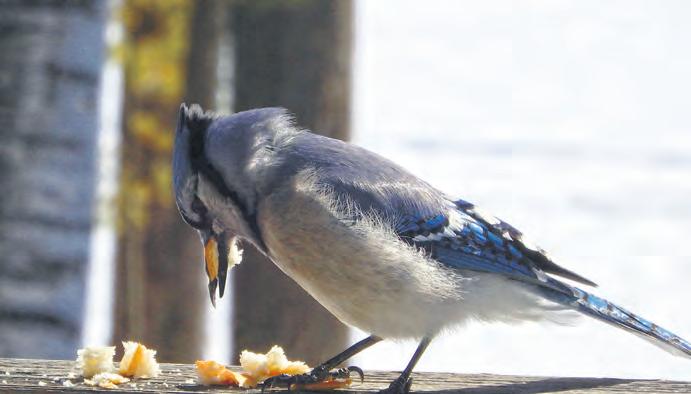
We’ve probably all been there. Rather than throwing stale bread away, we’ve broken it up and thrown it out for the birds. But regularly feeding bread to birds can lead to problems for them. Bread is high in carbohydrates, and therefore does not provide the right balance of nutrients that birds need to thrive.
Garden birds require a protein-rich and high-calorie diet. Ideally, they should be eating a combination of insects such as mealworms, seeds such as sunflower hearts, peanuts, and fat.
While bread isn’t directly poisonous, too much of it can act as an “empty filler”. This means that over time it will leave birds suffering from conditions associated with malnutrition. Unfortunately, once malnutrition has set in, it can be incredibly difficult to reverse the effects.
Bread also contains considerably fewer calories than birds need to survive.
Watching birds splash about in a bird bath will bring joy to just about anyone. Bathing regularly helps birds to keep their feathers clean so they can keep flying properly. But providing fresh water is more important than you might think.
A big bird-feeding mistake people often make is forgetting to put out fresh water for the birds. Birds need to drink and bathe daily – especially in hot weather. So fresh water can literally be a lifesaver in the summer.
It’s important to also keep this water clean – change it every day and make sure you don’t site it too near your feeders, as it could become contaminated with food. It’s a good idea to give the bath itself a good scrub regularly too, especially if it receives lots of visitors.
Birds need protection and cover. If space allows on your property, it’s useful for birds to have a safe place to feed from (and bathe!) comfortably.
Birds like cover, so put your feeders near to areas where birds can quickly flit back and forth. If your garden is also visited by lots of neighbourhood cats, then consider how close they can get to the birds, too. It’s important to put bird feeders in places where birds feel safe from predators, so make sure they aren’t too low.
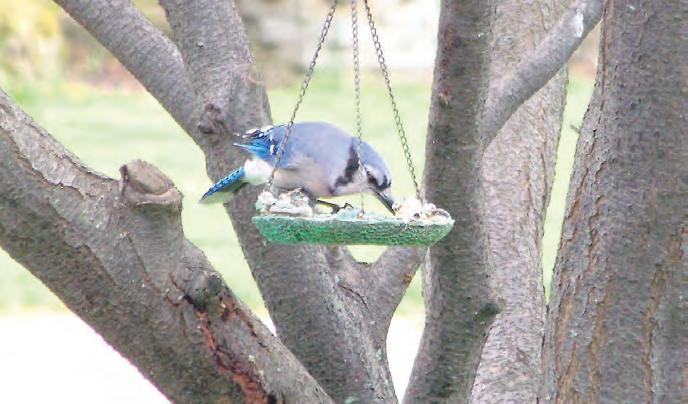
Different species have different needs. Not all birds feed in the same way, so your best efforts at nurturing your feathered friends might not be as successful as you’d hoped. Ensure that you use the correct type of feeder for the birds in your garden, or that you want to attract to your garden. Blackbirds and robins are ground feeders, and prefer tables or lower surfaces, whereas tits and sparrows prefer to feed from hanging stations. Setting up an array of feeders will help you care for a wide range of birds.
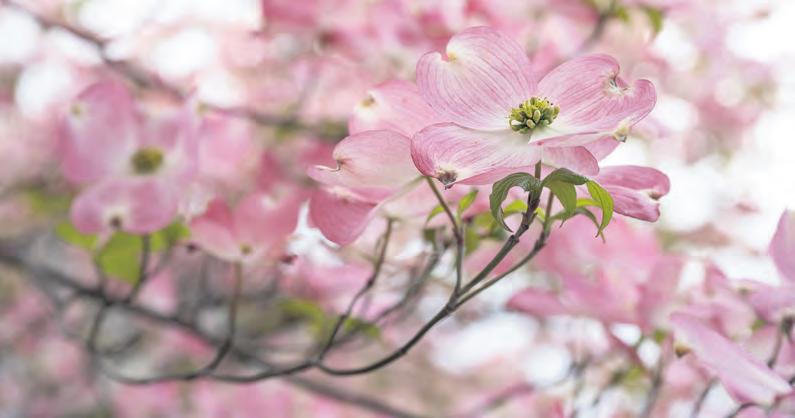
Many of the larger dogwoods make wonderful specimen trees or for adding height and interest to the back of a mixed border. They can be underplanted with spring-flowering bulbs or used as part of a mixed wildlife-friendly hedge.
Dogwoods have a bit of a reputation- not always favourable.
Slow growing and with varieties which can be invasive critics say they can be expensive to buy and be too big to really grace a border.
Yet the good news is they are wonderfully colourful shrubs with a range of shapes and sizes which if planted correctly can adore the back of a border with colour and style.
They produce bountiful, long-lasting displays of elegant spring blooms, usually white or tinged with pink. Low maintenance and slow growing, they come in a wide range of shapes and sizes, for rich soil in sun or dappled shade
This versatile group of dogwoods (Cornus) can be grown as a feature trees or a large shrub.
Once you’ve decided what size of plant you’d like, the next choice is the flower size and shade of white or pink. It’s worth noting that most flowering cornus produce immature green flowers, which then change to their mature colour (so the one as advertised on the label), before typically turning pink later in summer. So just be aware that if you want pure white, you will still get pink tinges as the flower bracts age.
C. mas and C. officiinalis are tougher winter flowering types that usually establish more easily and bring cheerful yellow blooms to announce that spring is nearly here.
Cornus are an investment – in time as well as money – so it is important to consider their eventual size and give them the growing conditions right. However, with show-stopping flowers and a graceful habits, they are worth the extra effort.
Some flowering cornus are available in garden centres, but you will probably get
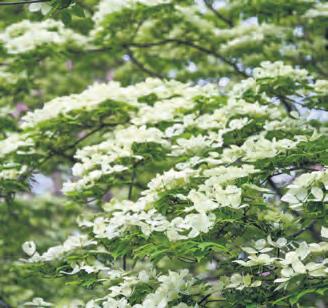
a bigger choice from specialist nurseries and mail order suppliers.
They are available in pots with sizes ranging from small younger saplings to large mature specimens.
Flowering dogwood can be planted from autumn to early spring. As their delicate papery leaves are prone to scorch and browning around the edges due to not quite enough water at the roots, summer planting is best avoided. Make the most of these trees and shrubs by planting them in the sun or dappled shade.
Flowering cornus really thrive on moist but well-drained soil. Cornus kousa (from Korea and Japan) prefers neutral to acidic soil; whereas north American species, such as C. florida and C. nuttallii, are more tolerant of neutral to alkaline soils. While it’s hard to change soil pH, you can improve moisture retention by improve it before planting by digging in a bucketful of well-rotted garden compost, leaf-mould or manure per square metre.
As slow-growing trees, they can take their time to establish and will often need watering in dry spells for at least three to four years after planting. But, once they have made themselves at home, they will prove it’s been worth the extra care
Flowering dogwood do take their time to establish, so will require watering regularly up to four years. After establishment, they will only need watering during long dry spells (drought)
Do check the soil is actually dry before you water, as the papery leaves of flowering cornus are very good a wilting just to cope with the heat and will perk up again once the sun is lower in the evening
A recent survey amongst National Trust members found that when it comes to planning a day out, we are a nation of people acting on impulse. Over 70 per-cent of those asked said there wasn’t a lot of planning involved in their day trips out . It was a case of ‘Lets go somewhere tomorrow’.
And that’s the perfect way to do it.
In July, warmer, longer days provide the perfect opportunity to get out and about. But the biggest incentive is that we are now working towards high summer when gardens have everything they have to offer in full display and there’s the time to enjoy the colour and the glory. We are again delighted to offer you with some suggestions of places to visit plus some events which you might like to add to your calendar.
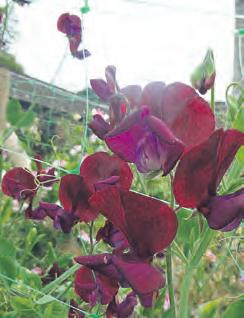
Forde Abbey on the Dorset and Somerset border is preparing for what promises to be a spectacular fortnight of sweet pea displays.
The themed ‘Summer of Sweet Peas’ runs from Monday 1st July to Monday 15th July with the gardens open from 10.30am to 5pm.
Last entry is 4pm. As always, the abbey gardens have prepared a wonderful array of sweet peas carefully chosen and sown.
The sweet pea wigwams have all been spruced up and planted.
The peak time the gardens are expecting the sweet peas to be at their best is early July. Bunches of cut sweet peas will be available at the Gift Shop.
Forde Abbey Estate, Chard, Somerset TA20 4LU
High summer and colour is everywhere in the popular North Devon gardens at Marwood From the fiery scarlet tones of Rosa Moyesii to the subtle hues of soft pink phloxes and the creamy frothy flowers of astrantia.



Marwood’s award-winning National Collection of Astilbes are well under way with a crescendo of gaudy pinks and reds to the muted tones of silver and white forms. Planted by the lakes and streams all are basking in the warm sunshine.
Stately bushes of Cornus Kousa grace the borders with their display of creamy-white bract like flowers while others turn rosy-pink.
A cheerful time of year with long days to soak up the enormous number of plants in flower. A great time for a cream tea at the tea-rooms and lots to buy at the fascinating plant sales. www.marwoodhillgarden.co.uk
Tel: 01271 342 528 Email: info@marwoodhillgarden.co.uk
Marwood Hill Gardens, Nr Guineaford, Barnstaple, North Devon, EX31 4EA
An RHS partner garden with a Grade 1 listed medieval priory backdrop boasts a mix of classic and modern features, including a ‘hot’ border, sub-tropical walk, blue garden, Mediterranean garden, shade border, Southern hemisphere and a winter garden. Home to Somerset’s only botanical glasshouse, featuring hundreds of different species from around the world such as the magnificent jade vine (Strongylodon macrobotrys). There’s also a gift shop, tearoom and specialist plant nursery; plants are propagated on-site and sold at great prices. Open Tuesday to Sunday, 10am to 3pm/4pm/5pm (seasonal), year-round excluding two weeks at Christmas. Last admission to the gardens is one hour before closure. The Walled Gardens holds a variety of events and special offers throughout the year suitable for all age groups. Please check the website for further information.
Email: walledgardens@btc.ac.uk Tel: 01278 655042
Church Street, Cannington TA5 2HA




The Bishop’s Palace garden in the heart of the City of Wells has an exciting summer ahead. The 14 acres of tranquil gardens in the heart of medieval Wells will be hosting a series of summer events for the family including a Tournament of Knights, Hansel and Gretel Opera and two nights of Shakespeare. The focus of course remains the stunning, gardens in the heart of Wells. You can wander along and around the many herbaceous borders, savour the scent of roses in the parterre, admire the beautiful views of the gardens, moat and further afield from the top of the ramparts.
Over the years the gardens have changed as successive bishops have added their legacy and today these gardens have Grade II listed garden status due to their historic nature. In 2016, the gardens were acknowledged by the Royal Horticultural Society, by being made a “Partner Garden”.
Entry is free most Fridays to RHS members with starred cards. This offer is not valid on certain event days so check the website for details where you can find details of all the summer events being held.
July 1st marks Whatley Manor’s 21st anniversary and to celebrate this milestone the venue will be hosting a series of special guests that will bring their unique talents to the hotel.
The celebrations will kick start with internationally renowned mural artist, Matt Wiley of ‘The Good of the Hive Project’ who will be creating a bee mural to continue the storytelling of the connectedness of people and planet.
Parvati Perkkio, master of Energy who has been leading groups and retreats for over two decades world-wide, will be holding a YogaShaking & Meditation Wellness retreat on 6th –8th September.
On the 8th and 9th November, Internationally acclaimed DJ Besford, will be taking control of the decks, bringing his mix of ambient and uplifting sound elements ranging from primal percussions to acoustic instruments, from deep spiritual voices to natural atmospheres, that create a unique musicality in its own right.
For more information visit www.whatleymanor.com, call 01666 822 888 or email

14 acres of tranquil RHS partner gardens, moat, medieval Palace building and award winning Bishop's Table café in the heart of medieval Wells.
Tickets to the Palace and gardens are valid for 12 months from purchase on any normal sightseeing day.
Purchase on site or online at: www.bishopspalace.org.uk
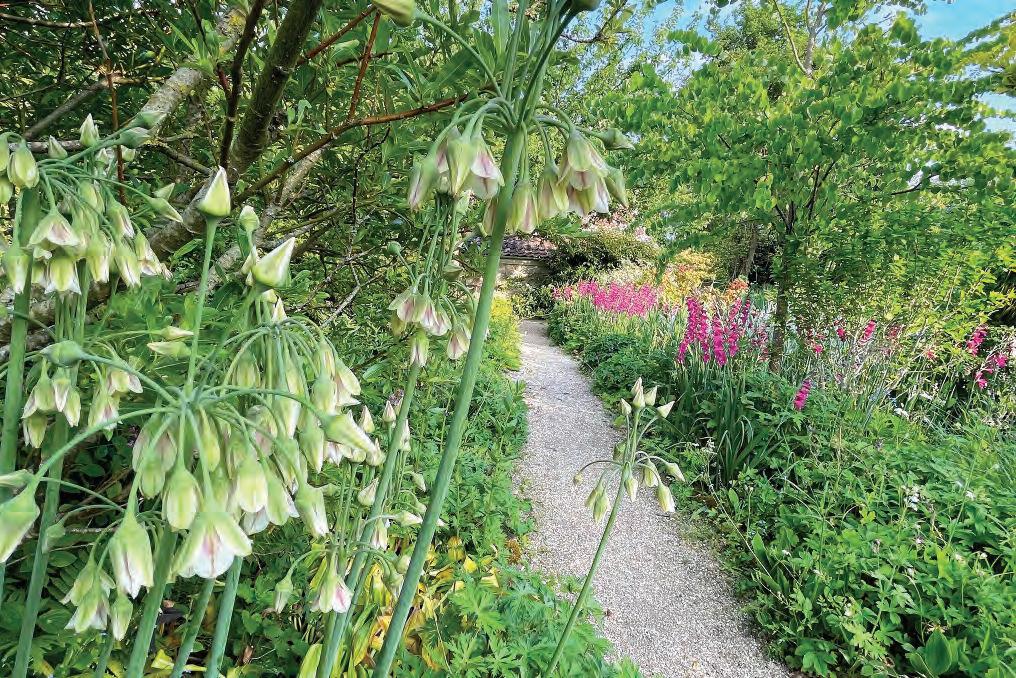
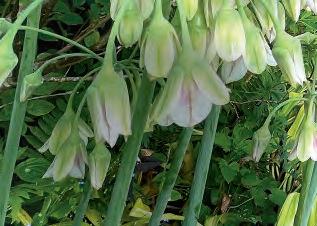
JUST 5 MINUTES FROM THE A303 AT SOUTH PETHERTON

England’s foremost cottage garden
Iconic cottage garden, nursery, café and gallery
A visit to the iconic garden of gardening legend Margery Fish is always a joy, never more so than in July when it is sublime.
Open Tuesday to Saturday | 10am to 5pm | Children under 16 and nursery entry free East Lambrook | South Petherton | Somerset | TA13 5HH | 01460 240328 | eastlambrook.com
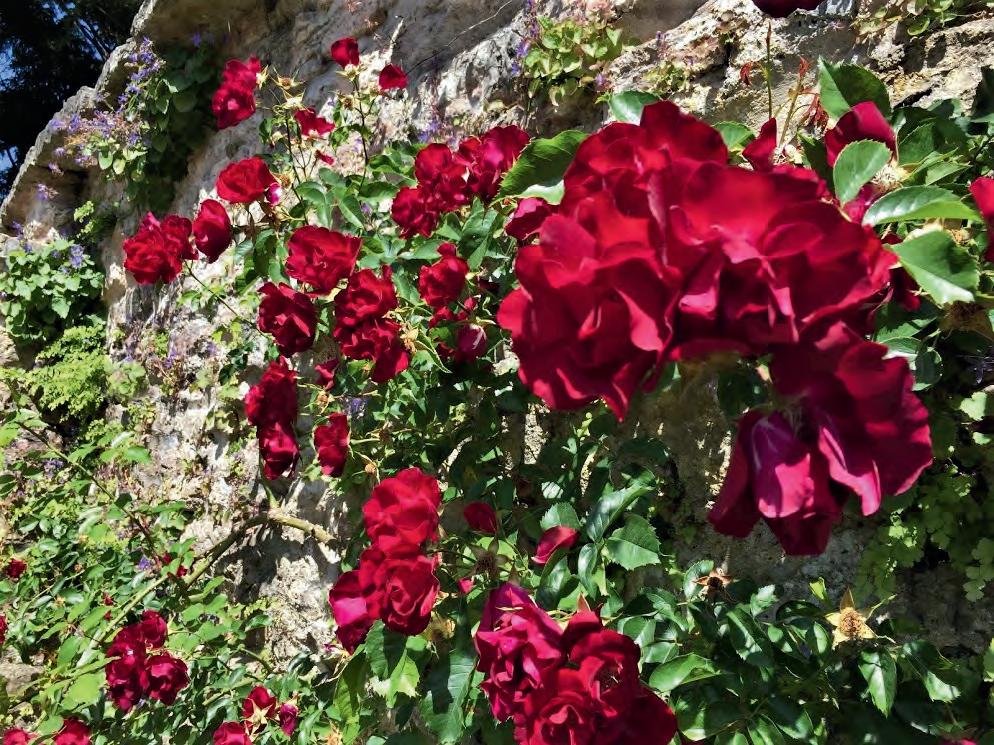
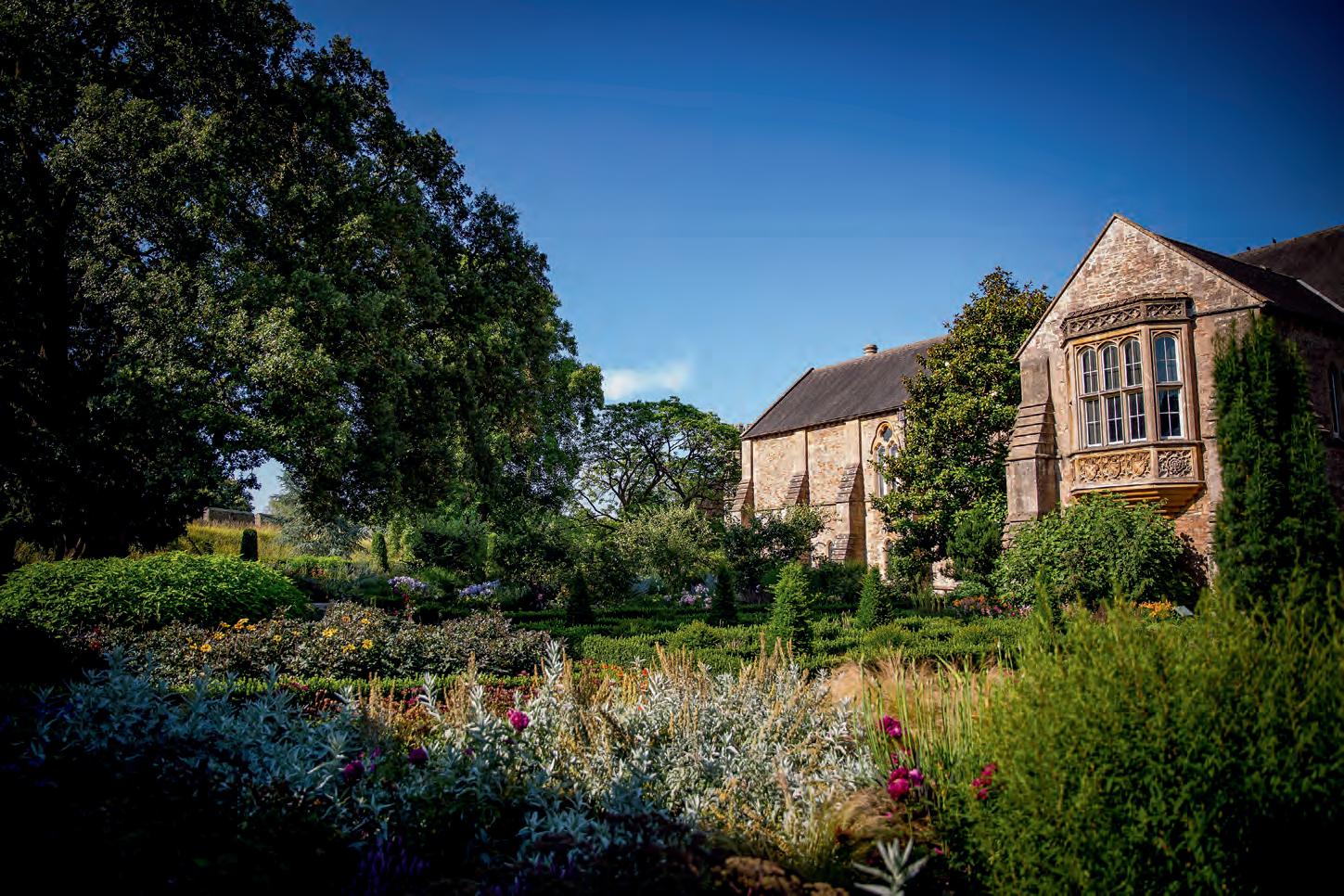

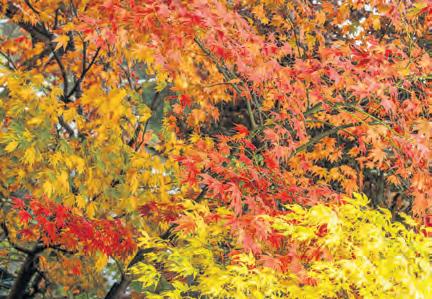
Barthelemy and Co near Wimborne Dorset is a Japanese maple nursery that was founded in 1920. From sourcing and picking the seeds, some years over 100,000 Japanese maples are produced and grown each year on the nursery by the Skinner family. Approximately 10-12,000 of these seedlings go on to be grafted with named varieties, using techniques passed down through the generations. Their focus on Japanese maples has allowed them to perfect their growing and grafting techniques, producing some of the finest specimens available in the UK. Barthélemy & Co is not just a place to buy plants, but a living museum of horticultural history, where every aspect of the growing process is done with care and attention to detail. Visitors to the nursery can see the passion and dedication involved on display and leave with a new appreciation for the beauty and complexity of these unique and captivating trees. Barthelemy and Co, 262 Wimborne Rd W, Wimborne BH21 2DZ
The borders at Cadhay Manor will be at their best in July and it will be interesting to see the subtle changes now there is a new gardening team under the leadership of Marcus. After several years with very little weed in the medieval fishponds, this year is not so lucky but the gardeners are keeping them clear so that you can enjoy the water lilies which are now firmly established. The dahlias should be as good as ever and the allotment holders have been extra busy in their plots. Cadhay is just outside Ottery St Mary with the postcode EX11 1QT.The gardens are open from 2pm-5pm every Friday afternoon and more details can be found on cadhay.org.uk Cadhay Manor, Ottery Saint Mary EX11 1QT
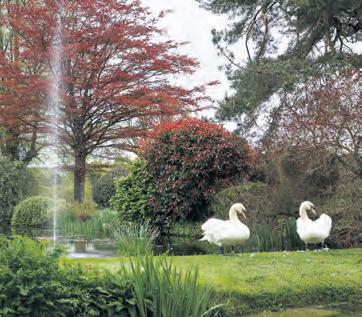
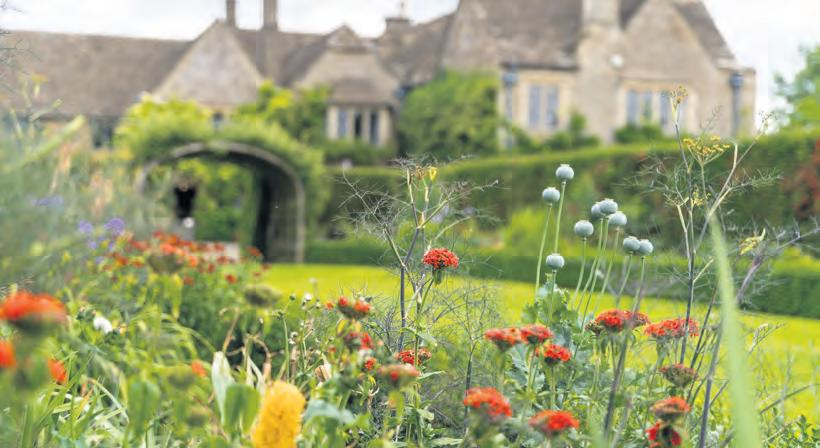
Whatley Manor Hotel & Spa
Easton Grey, Malmesbury, Wiltshire SN16 0RB


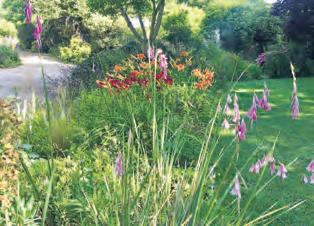
July is a fabulous time to visit the famous Grade 1 listed cottage garden at East Lambrook Manor. Created by the renowned plantswoman Margery Fish in the 1940s, 50s and 60s, it was made famous through her seven books, all based on the knowledge and experience she gained through turning a derelict wilderness into an iconic cottage garden.
Her first book written in 1956, We Made A Garden, was republished in June for the umpteenth time and is the story of how she, a novice gardener in her mid-forties, and husband Walter moved from London to Somerset and made a garden. The book has inspired generations of budding gardeners.
The garden has changed little since Margery Fish’s day and is loved by many for its cottage garden abundance and its ability to inspire visitors with planting ideas for their own plot. Many cottage garden favourites can be bought in the garden’s excellent Margery Fish Plant Nursery.
The Malthouse Gallery, situated in the garden, is host to the annual summer exhibition of local watercolour artist Moish Sokal, celebrating 30 years of exhibiting in the gallery, and delicious cakes can be enjoyed in the Malthouse Café.
The garden, nursery, café and gallery open Tuesday to Saturday, 10am to 5pm. Tel: 01460 240328 www. eastlambrook.com
East Lambrook Manor Gardens, Silver Street, East Lambrook, South Petherton, Somerset TA13 5HH
Choose your dining options at Whatley Manor
The highly acclaimed Michelin-starred restaurant, The Dining Room, under the direction of Executive Chef, Ricki Weston serves dinner from Thursday to Sunday. Popular with locals and guests alike, Grey’s Restaurant, offers an innovative menu full of great flavours in a relaxed setting, perfect for dinner each evening.
The Casual Dining Menu is served from 12 noon each day. Or why not indulge in Afternoon Tea with family and friends.
Find out more about packages and to book visit whatleymanor.com or call reservations on 01666 822 888.

We produce and grow the largest selection available in the UK. Plants are pot grown and suitable for garden, patio or bonsai.
Visitors welcome Mon-Sat 9am-1pm & 2pm-4pm
Barthelemy & Co (DCG), 262 Wimborne Rd West, Stapehill, Wimborne, Dorset BH21 2DZ
Tel: 01202 874283 enquiries@barthelemymaples.co.uk www.barthelemymaples.co.uk
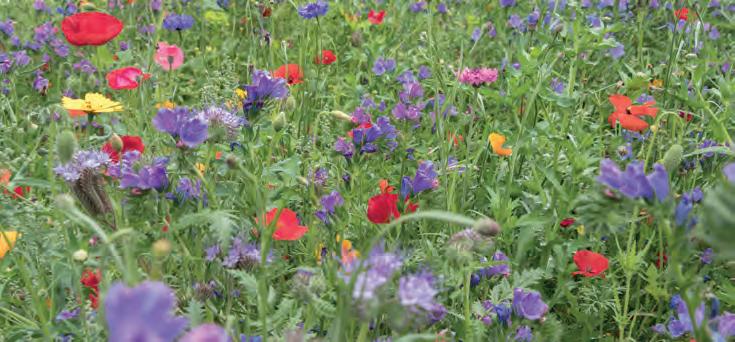


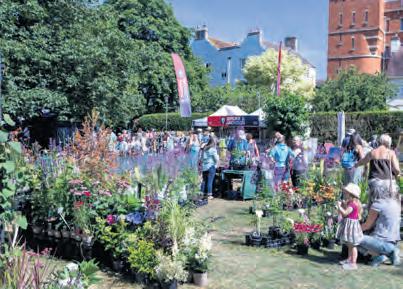
The most popular and oldest flower show in the South West is back and once again there is so much more than flowers to see! Taunton Flower Show will be opening the gates to Vivary Park on Friday 2nd and Saturday 3rd August for two glorious days of entertainment, shopping, eating and fun.
Enjoy the amazing floral and competition marquees, as well as dazzling entertainment and stunning show garden, built especially for the show. There are many traders, including local designers, artists, makers and food traders in our artisan village. Tickets are available now and children go free with a paying adult. It’s a quality day out for all the family! Website – www.tauntonfs.co.uk
Boscrege, a Cornish experience to dream of awaits you
Boscrege Caravan and Touring park in Cornwall is a peaceful and picturesque park, set at the foot of Tregonning Hill, Godolphin National Trust and amongst tranquil Cornish lanes in an area of outstanding natural beauty. The park, open all year is close to the Cornwall coast and a few minutes’ drive to Praa Sands, one of Britain’s (doggie friendly with dog n Cornwall in a either a self-catering caravan, lodges touring or even purchasing your own holiday home then

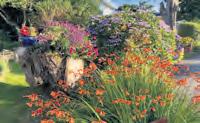








welcoming atmosphere,set in12 acresofCornish countryside, BoscregeCaravan & TouringPark isthebest place to
sandybeaches in
Praa
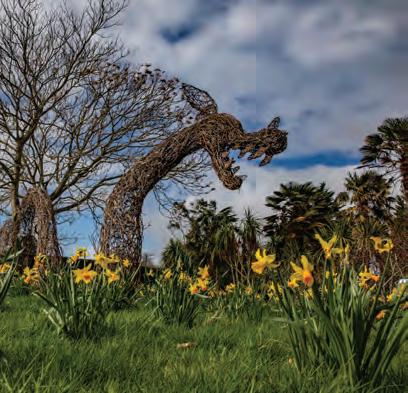
and visit our RHS partner garden. Enjoy light bites and refreshments from the Tea Room, buy plants from our Nursery, or simply explore the beautiful gardens – there is plenty to see and do! Scan the QR code for more






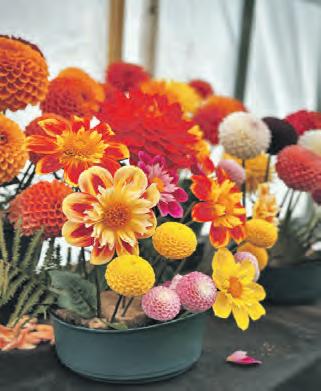



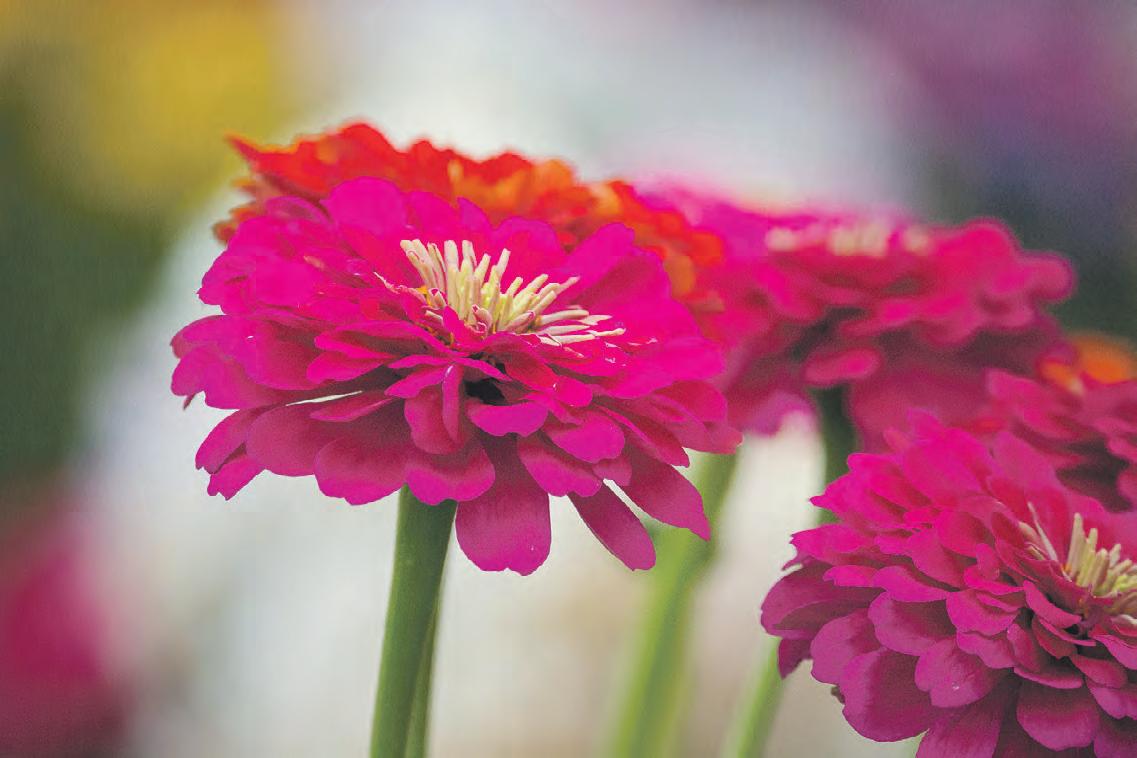




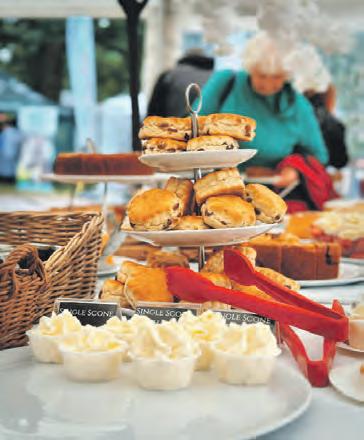







The Honiton Agricultural Show is planning for a great celebration of rural life in the East Devon Countryside on Thursday 1st August. There’s a fabulous array of entertainment including a welcome back to the Shetland Pony Performance Display Team raising funds for charities.
The show will include have children’s entertainment in abundance; animated characters Sheridan the Sheepdog and Pumpkin the Pony, the Twistopher Punch & Judy Show and Professor Crump, on his stilts .Craft Studio (Follies) will have workshops offering the chance to make jewellery, masks and flags.
At the heart of the show are all the livestock and horses including the majestic heavy horses, private driving and a huge variety of differing sheep breeds and dairy and beef cattle. With an array of shopping on offer, fabulous food and drink to tickle everyone’s taste buds and the wonderful cookery theatre with demonstrations throughout the day, there is something to appeal to the family on East Devon’s Premier Day out!
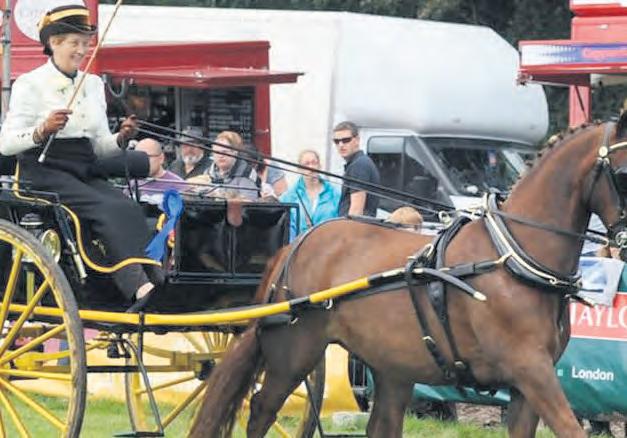
For further details on the show or information on becoming a member of the association and enjoying all the benefits contact the secretary on 01404 41794. Gates open at 8am until 6pm.
Discounted tickets are available now at £18 in advance (show day prices £20 held from 2023 and two accompanied children (Under 16) are admitted free! www.honitonshow.co.uk

Over the past five years, in June and July, visitors to Hartland Abbey and its gardens have witnessed lots of extra activity in the gardens - cameras, children in yellow dresses and boaters, old cars, ponies and everything and everybody that contribute to the making of a lovely TV series! Hartland Abbey was chosen in 2019 by the BBC to be Enid Blyton’s ‘Malory Towers’ but this summer is the last – Book Six is the final series. The interior of the Abbey, The Walled Gardens, the Shrubbery and the headland at Blackpool Mill have all featured in every series. The film crew and cast have been very accommodating to visitors and many children have hugely enjoyed watching the filming of their heroes! The main reception rooms in the house will be closed until Sunday 14th July for the last time – from that time on peace will return to the valley once again!
Hartland Abbey, Hartland, Nr. Bideford, N. Devon EX39 6DT 01237441496/234 www.hartlandabbey.com for all information.

The Gillingham & Shaftesbury Show which takes place on Wednesday, 14th August and Thursday, 15th August is not just any agricultural show. This year, visitors can expect spectacular camel racing alongside the region’s finest livestock parades. There’s the chance to enjoy two rural days out with horticulture exhibits, vintage steam engines and cars, heavy horses, plus countryside displays including ferret racing, gun dogs and falconry.

IN THESE LOVELY GARDENS AND
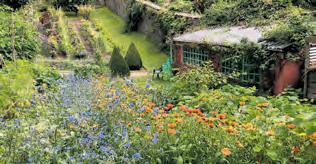
Visit our fascinating family home with its beautiful Walled and Woodland gardens, Fernery and Bog garden, walks to the Atlantic Coast, stunning architecture, collections, displays and film exhibition. Location for Enid Blyton’s ‘Malory Towers’.
* Dogs welcome * Holiday Cottages *
* Homemade light lunches & cream teas * Hartland Quay 1 mile*
Sunday to Thursday until 3rd Oct 11am - 5pm (House 2pm - 5pm last adm. 4pm) (NB: Main reception rooms will be closed for filming 17th June - reopen 14th July)
For more information and special events see www.hartlandabbey.com Hartland, Nr. Bideford EX39 6DT 01237441496/234
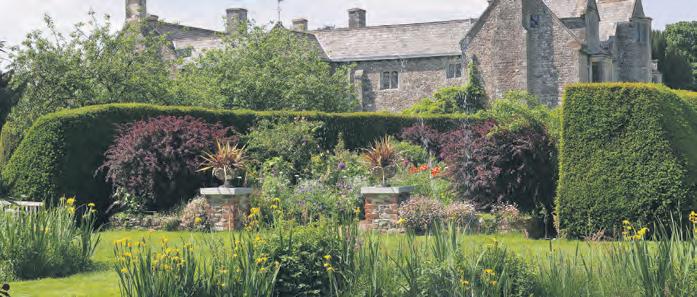

GARDENS & TEAROOM
Open every Friday 2pm - 5.30pm from 3rd May to 27th September
Also last weekend in May & August Bank Holiday weekend - Sat, Sun & Mon GARDENS: adult £5, child £1


There’s also Shetland pony racing, showjumping, a showcase of Dorset food and drink as well as live music. Whether you’re an animal lover, machine enthusiast or gardener – you won’t want to miss this famous Dorset show. Advance tickets available now. Children up to 15 go free. Free parking. Dogs on leads.
www.gillinghamandshaftesburyshow.co.uk

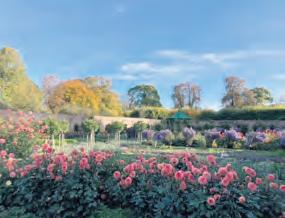
The popular programme of Rare Plant Fairs continues during July, with events held in unique gardens with their own individual style, making a visit to one (or more!) of the events a great day out. A fabulous selection of specialist nurseries attends each of the fairs, all of whom are experts in the plants that they grow. The full programme is :
WINTERBOURNE HOUSE AND GARDEN, Birmingham, Sunday July 14th, 10:30am-5pm. Winterbourne is one of the best surviving examples of an Edwardian Arts and Crafts suburban villa garden. Today, the botanical garden contains plants from around the globe with collections of plants from China, North and South America and the Alpine areas of the world.
MANOR HOUSE GARDENS, Bledlow, Buckinghamshire, Sunday July 21st, 11am4pm. Bledlow Manor House has been owned by the Carrington family since the 18th century. After the 7th Lord Carrington inherited the garden, he commissioned the plantsman and designer (and long-term friend of Rare Plant Fairs!) Sean Walter in 2019 to lead on an extensive replanting and rejuvenation project throughout the gardens. The present garden covers about 12 acres, and utilises a mixture of different terrain and styles, ranging from a Japanese style water garden on converted old cress beds, a walled kitchen garden, to a contemporary sculpture garden. Visit www.rareplantfair.co.uk for full details of the events, including admission charges and a list of the exhibitors attending each one.
Visitors will be able to experience a revelatory new exhibition at Kelmscott Manor , “Mountains and plains and adventure: William & May Morris and Iceland”. Celebrating the centenary of May Morris’s first trip to Iceland, the exhibition showcases previously unknown diaries, artifacts, and art reflecting the Morris family’s deep connection to Iceland. Visitors will discover May’s adventures and compare them with William Morris’s iconic visits. Curated by Dr. Kathy Haslam and Dr. Emily Lethbridge, the exhibition highlights themes of travel, culture, and legacy, featuring items from the Society of Antiquaries, the British Library, and more. Visit the website for opening times and ticket prices.
Kelmscottmanor.org.uk
Kelmscott, Manor, Lechlade GL7 3HJ



14th July
Winterbourne House and Garden, Birmingham B15 2RT 21st July
Manor House Garden, Bledlow, Bucks HP27 9PA
www.rareplantfair.co.uk
Please visit our website for full details of admission fees and times of opening.
We look forward to welcoming you on Thursday 1st August 2024
Fabulous entertainment, Delicious food and drink, Over 400 trade stands.
Majestic livestock and horses, Bees and honey, Dog show, Vintage tractors and classic cars, West of England hound show, Cookery theatre.
Please apply for trade, livestock and horse schedules.



ADVANCE TICKETS JUST £18 (ACCOMPANIED UNDER 16 GO FREE) AVAILABLE FROM www.honitonshow.co.uk
Secretary: Marcelle Connor, Bank House, 66a High Street, Honiton, Devon, EX14 1PS info@honitonshow.co.uk


Nestled in the heart of North Devon, Marwood Hill Garden is a hidden gem
Home to four National Plant Heritage collections, this private valley garden spans over 20-acres and showcases three stunning lakes, rare trees & shrubs, and colourful surprises throughout each season. Not only a haven for wildlife, the garden is also the perfect environment to explore and be inspired. Enjoy a day of inspirational and relaxation for the whole family.
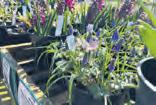

July is often one of the hottest months of the year and a great time to sit out and enjoy your garden. Keep plants looking good by regularly dead-heading, and you’ll enjoy a longer display of blooms. Make sure you keep new plants well watered, using grey water where possible, and hoe off weeds, which thrive in the sunshine. There’s plenty to do to keep the display going and to enjoy great crops, including harvesting veg at its peak and feeding the lawn. Summer is progressing.
Anything you’ve planted in the past few months will need regular watering while it puts out roots into the surrounding soil and establishes itself. Make sure that you give these plants a thorough soaking rather than a gentle sprinkle.
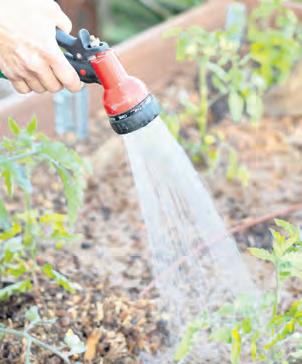
Try to maintain a green/ brown balance in the compost heap throughout the summer. Green materials are soft, high in nitrogen and not necessarily green in colour, for example coffee grounds, veg peelings and leafy prunings. Brown materials are often drier, more fibrous and with a higher carbon content, for example, twigs, cardboard and wood (but not coal) ash. In the summer, most ingredients are green, which results in compost heaps with a lack of structure and air being squeezed out, so it’s important to add an equal proportion of brown ingredients.

There are lots of veg that can be sown over the next few weeks to fill gaps as earlier crops are cleared and to give fresh veg into the autumn and winter.
• Sow kohlrabi, lettuce, leaf beet, chard, endive, chicory, Florence fennel, chervil and coriander.
• Finish sowing beetroot and savoy cabbage in the first week of July.
• After mid-July, sow land cress, Chinese cabbage and spinach.
• From the end of July to mid-August, sow mustards, pak choi and salad rocket.
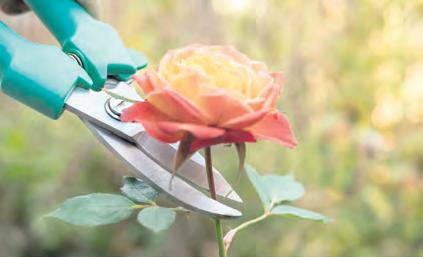
5
Most flowers lose their attraction as they fade, spoiling the overall appearance of beds, borders and containers. Removing these, by deadheading, helps keep displays looking better for longer. Deadheading also directs energy into stronger growth and more flowers, instead of (often unwanted) seed pods.
• Prevents plants with numerous petals, such as peonies, some camellias and many roses, scattering old petals widely
• Prevents plants from self-seeding – particularly useful for plants that self-seed readily and can become a nuisance, such as common valerian (Valeriana officinalis), sea holly (Eryngium) and lady’s mantle (Alchemilla mollis)
Supporting your plants is one of the most important jobs in June and July when there is often a great deal of height in the garden.
• Stake tall growing bulbs such as dahlias, lilies and gladiolus. Their flowers will make them top heavy and liable to blow over in the wind without some support.
• Loosen ties on trees and standard roses if they are becoming too tight. Fix tree ties so the buckle is on the opposite side of the stake to your tree, remembering to put the spacer in the middle to prevent chafing. Allow a little space for growing room but have it sufficiently tight so the tree cannot jiggle around excessively in the wind.
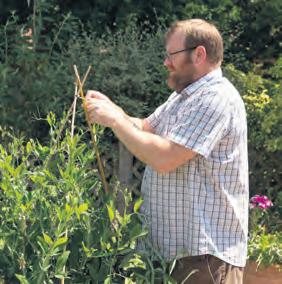
4

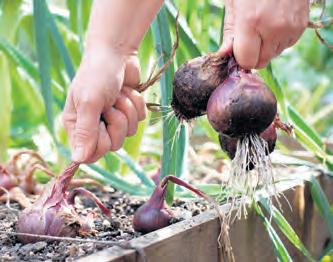
In about the middle of July, watch for when about two thirds of onion tops are falling over, then push the rest down to soften the neck as sometimes they can develop a long stem and a neck that doesn’t dry very well. You don’t need to wait until the tops go yellow before lifting, but you’re looking for the bulbs to begin to change colour.
Pull them up and put them in a crate without being crowded so that air can circulate around them. Put it somewhere undercover such as in the greenhouse or garage.
Allowing them to dry like this is important as they will store better. Done this way they should keep until spring.
After they’ve dried in the crates for about a month, they’ll be ready to bunch up and hang in the house or in net bags until you need them.
7
Keep your pond healthy and looking good
• Look out for any yellowing leaves. If they are left on water lilies and other water plants, remove them promptly. Allowing them to fall off and rot in the water will decrease water quality.
• Remove blanket weed. This will let oxygen into your pond. Use a net or rake and remember to give aquatic life a chance to get back to the water by piling the weed next to the pond for a day.
• Top up water levels. Water can evaporate rapidly from water features and ponds in the height of summer, so top them up if the water level drops significantly. Rainwater from a water butt is best – chemicals in tap water can affect the nutrient balance in the pond.
• Hosepipe ban. If your area is under a hosepipe ban, you can still use it to top up your pond if you have fish.
• Clear filters. Remember to clean any filters and pumps.

Different plants have different nutritional needs and different fertilisers are available to meet them. Fertilisers are available in different combinations of nitrogen, phosphorus and potassium with a different mix being needed for different parts for the garden.
Nitrogen encourages the production of strong stems and foliage, so fertilisers with high nitrogen levels are best for lawns and leafy vegetables.
Potassium-rich fertilisers help nourish flowers and fruit without over-feeding the stems, making them well suited to plants like dahlias and tomatoes.
Phosphorus is essential for seed germination and for young plants to develop good root growth. Root vegetables such as carrots and turnips need a high phosphorous fertiliser.
July is a good time to take cuttings from shrubs and alpines. Take the cuttings from non-flowering shoots and place them around the edges of small pots that are filled with peat and perlite. Water the cuttings in and keep them warm but out of direct sunlight.
Lift, divide and replant congested and over-sized clumps of earlyflowering perennials such as bearded iris, polyanthus and pulmonaria once they’ve finished flowering. this will allow them to form roots and flower buds for next year in their new location before the weather gets too cold.
July and August are key months to trim hedges such as hawthorn as birds will have stopped using them for nesting. Trimming them keeps them looking neat and restricts their growth. You can use shears, secateurs or hedge trimmers depending on the size of the leaves. For example, with small-leafed shrubs such as privet, shears or hedge trimmers will work. However, for large-leafed shrubs such as holly, shears will be best.

Don’t forget to feed the roses
It is a good idea to feed your roses in midsummer as this will help them produce a second flush of flowers. For any roses that have finished their first flush of flowers, trim them back before feeding. Roses need pruning because this encourages them to produce new shoots, since cutting back a branch helps the rose to produce a growth hormone. When cutting them, make a cut 5mm above an existing bud with gardening shears. Ensure the cut is angled away from the plant as this prevents rain water from collecting and causing disease as a result.
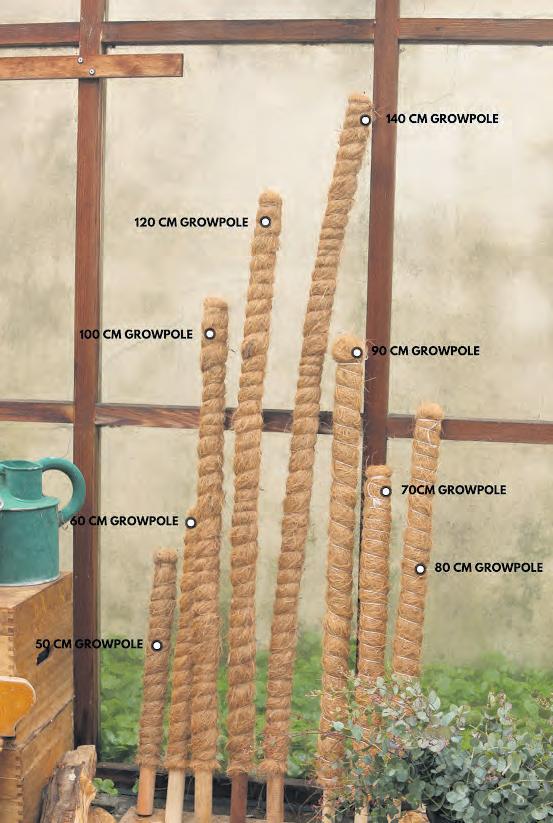
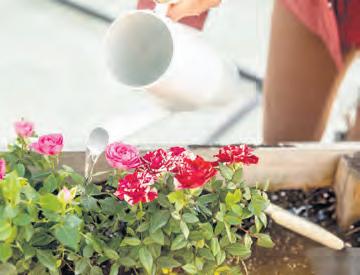

Vertical growing plants (also referred to as climbing or trailing plants) are ideal for adding a touch of charm and adventure to any garden space. They are also a great way to make the most of limited growing space whether indoors or out. CoirProducts of Salike®, coir moss poles or coir grow poles provide an ideal support for climbing plants and vines. Perfect for growing creepers and plants that need a lot of moisture, not only do the coir moss poles help provide these plants with structure, they also bring with them a host of sustainable benefits. CoirProducts grow poles are crafted out of natural fibrous material extracted from the husk of the coconut. The natural coir fibre is wrapped around a wooden pole, and secured with natural coir yarn for greater stability. With coir moss poles, you can easily replicate the natural environment of these plants, while also helping them grow healthier and stronger. Sturdy and versatile, CoirProducts coir grow poles are useful for providing moisture for plants. Coir has high water retention ability as well as excellent drainage, which allow aerial roots of plants to access the moisture they need.
With the largest range of coir growpoles in the UK, at CoirProducts they offer a unique and exciting range of sizes, from 50cm to 200cm. To use them, soak the coir moss pole in water for a few minutes, and simply place it close to the plant as needed. They can be placed on the ground or on a sustainable coir pot. The plant can then be arranged around the pole, using coir yarn or any other relevant material to secure the plant to the coir moss pole.
Coir moss poles have been a popular product since their inception. While they had previously offered coir moss poles with either PVC or wood, due to our aim of becoming more sustainable, they moved away from using harmful plastic poles and continue to offer wooden handle climber moss poles.
As a purpose-driven company, CoirProducts are committed to bringing products that not only benefit the user, but also has minimum harm on the environment. They ensure ethical practices are followed throughout the process of production and sourcing of all the products. Their commitment to sustainability is also seen in the holding company Salike® attaining carbon neutrality. With greenhouse gas emissions verified as per ISO standards, they offset any remaining carbon footprint in transporting goods to the UK as per UNFCCC process.
More gardens than ever before have a new soundit’s the sound of running water adding to the sensory experience without great cost or effort
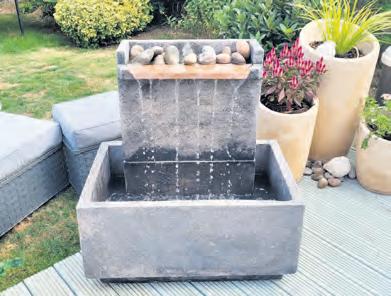
There’s little doubt about it- the presence of any sort of water feature in a garden adds something special. Including them in any sort of design will allow you to boost to the sensory experience of your garden, altering the mood and feeling, or bringing life and movement to even the smallest outdoor space. It needn’t be expensive or disruptive and more gardeners are opting for something simple when it comes to adding water features
A fountain or cascade can be energizing and create drama, while the still, reflective surface of a pond, or gentle flow of water in a rill or stream, can provide a meditative and soothing experience.
Water features offer the opportunity to add an interesting array of aquatic and marginal plants and increase the biodiversity for wildlife.
Water feature ideas must work aesthetically and have purpose within the rest of your garden design. They don’t need to be complex, and sometimes the simplest designs will bring the most impact.
Before adding a water feature to your garden, consider what it is about one that appeals to you.
There are many garden pond ideas that can create a therapeutic focal point.
Is it the sound of moving water?
A still body of water reflecting the sky and bouncing light around the garden? Perhaps a mysterious inky blue pool set into a shady corner? It all differs from person to person. Whether you want a quiet and calm watery element, the gentle tinkling sound of falling water, or a dramatic flow, will influence the design and style of the water feature. Before adding a water feature to your garden, consider what it is about one that appeals to you.
Garden fountains
Garden fountains are dynamic water feature ideas that bring both sound and the visual impact of moving water to a garden.
They come in a wide range of possibilities, from a gentle trickle of water to a more dramatic, gushing flow.
The sound of water contributes greatly to the atmosphere it creates.
Fountains work well in ponds, but as a general guide the pond should be at least twice as wide as the height of the water jet to avoid water waste or surrounding surfaces getting wet.
Alternatively, self-contained fountains require little or no excavation work and often do not need to be installed by a specialist. Self-contained fountains need to be sited on a level footing, such as a patio, avoiding grass or undulating ground and work well in courtyard gardens.
One of the simplest ways to introduce water to your outdoor living room ideas is with a water bowl or dish. Any shallow container will work, but choose one that can be cleaned easily as they can become green with algae. Add aquatic plants to help to keep the water naturally clean and encourage wildlife.
Stone bowls, metal dishes, weathered steel dishes, recycled containers and all manner of objects can be turned into water features. Select one that is in keeping with the style of your house and garden.
Where possible, when topping up the water, try to use collected rainwater or tap water that has stood for a few days to allow some of the chemicals to evaporate.
The Oase way to help achieve water wellness in your garden
Did you know being near water can have a positive effect on your sense of wellbeing? You don’t need to add a huge pond, even a small self-contained water feature gives you the tranquil sound of moving water.
OASE want to make it as easy as possible for you to have a little bit of serenity in your back garden. From pumps to pre-formed ponds, to filters and fountains they have designed everything you need to add water to your garden.
Speak to their experts today – 01256 896886 enquiries@oase.com – www.oase.com

With an OASE fountain
The sound of moving water can transform your garden into a place of beautiful tranquillity. And OASE have a range of options to suit whatever space you have.
If you already have a pond, consider the Aquarius Fountain Set Classic. This reliable fountain pump comes with 3 nozzle options and can create fountains up to 2 metres high.
You might already have a small pond filtered by an OASE Filtral in-pond filter. Did you know these filters have the option of adding a fountain attachment? You can pick up the fountain attachment from an OASE retailer today.
Even without a pond you can still add moving water. OASE have a range of pond-free water features. These give you the flexibility to add water to any space.
Are you inspired to add some moving water to your garden? OASE have retailers all over the country who are happy to help you find just what you need. Or speak to us directly and our technical team will give you advice for your pond.

01256 896886 enquiries@oase.com www.oase.com
HAMPSHIRE HOUSEPLANT ENTHUSIAST ANDREW POYNER CHOSES SIX SENSATIONAL HOUSEPLANTS WHICH ALL HAVE AN UNUSUAL ELEMENT TO THEM - AND ARE ALL IDEAL FOR THOSE WANTING TO ADD TO THEIR INDOOR GARDEN COLLECTION
These days with some basic skills you can quickly and reasonably cheaply gather an amazing collection of houseplants- growing them like a circle of friends. I’ve set out to help you in this by selecting half a dozen plants which are slightly off the beaten track but equally very thrilling.
String of hearts (Ceropegia woodii) is a trailing house plant with heart-shaped grey leaves with attractive mottling, and pinkish undersides which is great fun to collect. In summer it may bear pink, tubular flowers. String of hearts is a succulent plant and is native to SouthAfrica and Zimbabwe.
Water regularly in spring and summer, allowing the compost to completely dry out between waterings. Reduce watering in autumn and winter, and never let the plant sit in waterlogged soil, as this can cause the roots to rot. String of hearts isn’t a particularly hungry plant, but it’s a good idea to fertilise pot-grown plants twice a year, in spring and summer.
Repot string of hearts only when it starts to out-grow its existing pot, moving it to a slightly larger container. Use a free-draining compost mix such as a peat-free cactus and succulent compost, or a peat-free house plant compost mixed with perlite. Repot in late-spring and summer, when it’s in active growth.
When people hear aloe they immediately think about aloe vera and how helpful it is to put on burns. However there’s a lot of aloe genus for the avid houseplant collector and fun to grow and collect.The lace aloe, Aloe aristata, is a low-growing evergreen perennial native to South Africa. It forms rosettes of fleshy, lance-shaped, softly spined green leaves with white spots. In autumn tubular, orange-red flowers appear on long stems. Although hardier than many aloes, it’s best grown as a houseplant or in a greenhouse. Aloe aristata grows best in full sun, in sandy, free-draining compost, such as cactus compost. Water sparingly and avoid watering in the dormant period (September to March).
Alocasia Amazonica, also known as Alocasia Polly is a hybrid between Alocasia longiloba x Alocasia sanderiana and prized for its beautiful leaves plant. It is a stunning tropical houseplant renowned for its unique foliage and striking appearance.
Some houseplant collectors are shy of adding this to their collection mainly because it has a reputation of being difficult to look after but get the conditions right and the plant will be enormously rewarding. Even the undersides of the leaves are interesting with fine veining. The challenge if there is one is to get the light and temperature requirements right. The plant needs lots of light and wellwatered environment. The plant is normally sold with up to three stems with mature leaves so don’t be sold short PEPEROMIA ARGYREIA
The Watermelon Peperomia is a fascinating fleshy leaved plant banded with greens and greys that sway
on central red purple stems. Peperomia argyreia have exploded in popularity among houseplant lovers thanks to their stunning watermelon-patterned foliage. They have a compact growth habit, and their leaves are not only colourful but also have a shimmery appearance that is especially stunning when the sunlight catches them. Native to South America, watermelon peperomia are tropical plants that grow naturally in the rainforest understory, and adapt exceptionally well to indoor growing. Overall watermelon peperomia are easy to care for and grow as houseplants, especially if you are good at staying on top of watering your plants. If you have a habit of forgetting to water your plants for weeks at a time, this plant might not be for you as peperomia are moistureloving plants. While they do produce flower spikes in the spring and summer, the blooms are insignificant. Some growers choose to cut the blooms off so that the plant can focus its energy on producing foliage, which produces much more visual interest.
The Hoya genus contains more than 500 species and most have thick, stiff leaves with a dull appearance which is well suited to their common name- waxplant. There are however some spectacular varieties for the keen collector. I have chosen Hoya linearis an intriguing hanging plant, with its curtain-like form it is a popular choice with hanging plant admirers. The plant is native to Eastern Asia and Australia and has a very tropical look - wonderful hanging tendrils spill from the plant and cascade down the sides like a waterfall.
It is perfect in an indoor hanging basket, placed in freedraining soil - it gives a luxuriant feel to a room, imagine walking through the rainforest where plants are hanging all around, punctuating the view.
It’s easy to care for, just imagine rainforest conditions - it loves humidity. With good care you may be lucky enough to get flowers in the spring and summer - these are creamy coloured and stunning.
Hoya linearis a wonderful trailing plant that adds panache to any home. It would also make a fabulous houseplant gift for someone special, being quite a cheap houseplant, and it gives real value for money.
Haworthiopsis coarctata, formerly Haworthia coarctata, is a species of flowering succulent plant from the Eastern Cape Province in South Africa
This slow-growing, clumping succulent has dark green leaves with white ribbing. The leaves turn pink to purple when stressed by sun or cold. Its long stems grow tall, with short, curved leaves.
It has typical watering needs for a succulent. It’s best to use the “soak and dry” method, and allow the soil to dry out completely between watering.
Haworthiopsis coarctata is not cold hardy, so it’s best to plant this succulent in a container that can be brought indoors. It does well in full to partial sun. The plant will produce small offsets, sprouting up around the base of the plant. Simply pull these up and allow the offsets to dry for one to two days before replanting.

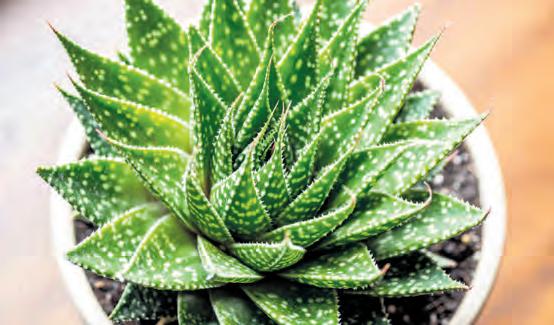

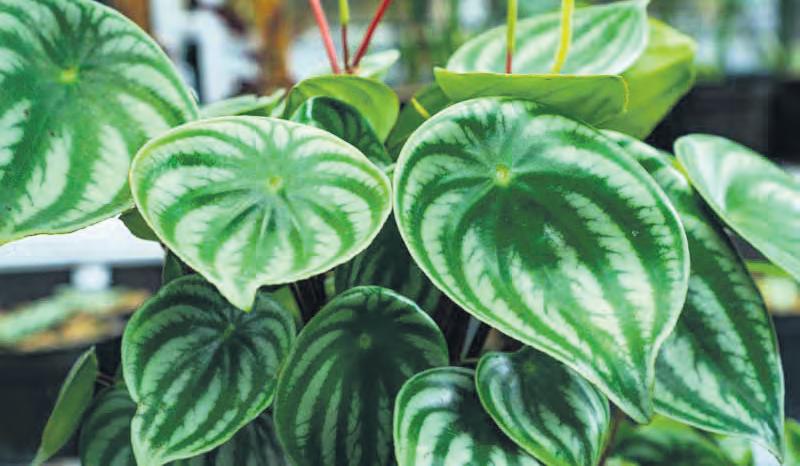
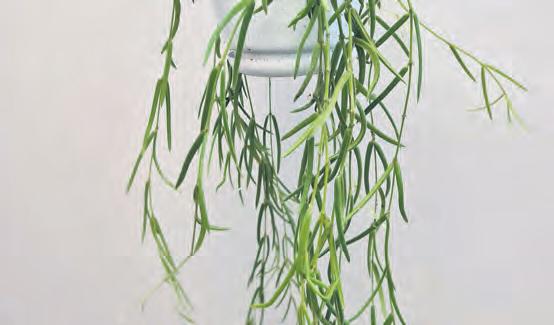
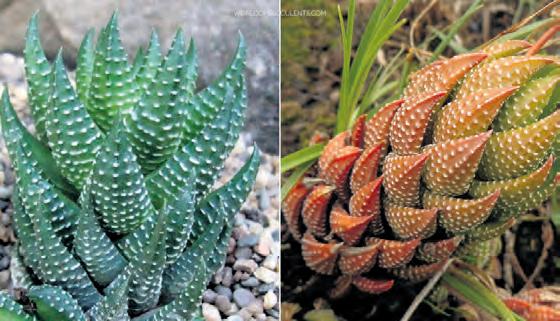 Alocasia Amazonica
Peperomia argyreia
Hoya linearis
Haworthiopsis coarctata
Aloe aristata
Alocasia Amazonica
Peperomia argyreia
Hoya linearis
Haworthiopsis coarctata
Aloe aristata
The number of questions and queries from gardeners all over the south west continues to pour into Country Gardener offices and we are happy to help where and when we can with what we hope is helpful advice and ideas. If you feel you need some specialist help then email us at editorial@countrygardener.co.uk or write to us at Mount House, Halse, Taunton TA4 3AD
I am well versed about the importance of deadheading roses but is the same true about tulips? I have again had a wonderful display this year but they are beginning to be past their best.
Patty Davison IlminsterIf you have tulips growing in borders, deadhead them once they have faded. It is very important you do so. This will stop the development of seed so that all the energy goes into forming new bulbs for next year’s flowers. The best way to deadhead them is simply to snap off the spent flower with the growing seed pod using your fingers. Do not cut back the stem or any of the foliage as this will all contribute to the growing bulbs as they slowly die back.
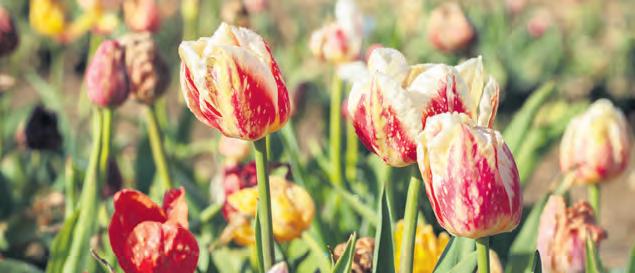

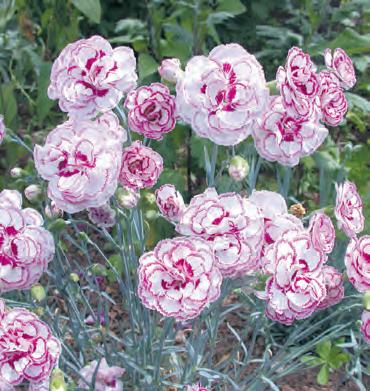
I’d like to pot something up, perhaps a perennial, that we can leave at my mother-in-law’s grave. The difficulty is that we only get to visit the church yard a few times a year so would want to plant something which can almost look after itself; could you recommend something nice but hardy that can deal with a little neglect?
Marie Porter BidefordOften it is possible to plant directly in the ground by the headstone, and this would be preferable as even the toughest plant will still need watering if it is grown in a container.
You would probably be best trying low maintenance perennials with a compact growth habit such as Primrose vulgaris, Polyanthus ‘Most scented Mix’ or Dianthus ‘Gran’s Favourite’. These could be under planted with spring bulbs such as Narcissus ‘Tete-a-Tete’ and Russian Snowdrops. All of these are resilient and should cope with a bit of neglect and you hopefully wouldn’t worry about how they were faring in your absence.
I have found in recent years that timing is everything when it comes to planting out tomatoes. I have had some success and some real failures. Is there a golden rule or should I wait as long as possible?
Peter Floyd Devizes
No, there is no rule about this -just common sense. A wise view would be to wait until early June. You will have nothing to lose because if the sun shines and the warmth comes they will catch up quickly. This is because tomatoes hate too much temperature fluctuation and May nights can be chilly - especially if the days are warm. Plant them deeply, burying them right up to the bottom leaf as the buried section of stem will develop extra roots. As the young plants grow they form shoots between the leaves and the stem and these are known as side-shoots. They grow with extra vigour and although they do bear trusses of fruit, they take energy from the plant and reduce the overall harvest as well as making a cordon plant straggly. So, they should be removed as they appear.
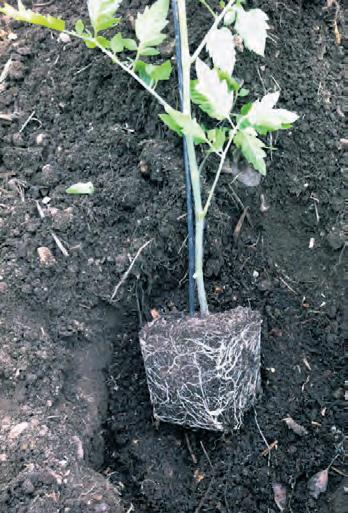
My mother is finally and sadly moving out of her Honiton cottage. The move has given us a thought .How easy is it to take cuttings of one of her lovely old roses which have been at the heart of the garden for so long. We are not great gardeners, but it seems such a lovely thing to at least try to do.
Linda Service,Plymouth
It’s a straightforward process and they don’t require much attention. The process certainly shouldn’t worry you. Cut out some strong, healthy stems from this year’s growth - do not use older wood. To prepare the cuttings, cut your chosen stems into lengths of about 25cm. You will need to cut just above a bud at the top of each cutting and just below a bud at the bottom. Remove all the foliage except for one leaf at the top of each cutting. Dip the base of the cuttings into a rooting hormone if you have some available, before pushing them into a pot of gritty, well drained compost. Don’t use multipurpose compost. John Innes No 3 or even some well drained garden soil is preferable. You can fit several cuttings to a large pot if you position them around the edge. Place the pot in a sheltered, shady spot and keep them well watered. They will root over the winter months and by next summer should be ready for potting up into individual pots and growing on.
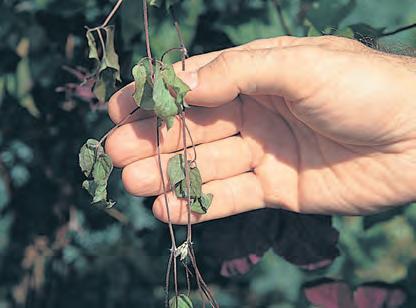

I have three much loved clematis plants which have adorned our garden climbing up our trellis and flowering every summer in bright, dramatically large flowers. This year nothing but what seems to be dying plants. We think the plants are about 15 years old and haven’t done anything different in terms of looking after them.
Teresa Davis IlminsterMost clematis will live for between 25-50 years depending on growing conditions and health so it doesn’t feel like old age is the problem. The lifespan of clematis plants can vary significantly depending on the species and variety. Some species, like Clematis montana, are known to be particularly long-lived. The main reason for clematis dying is waterlogged soil. Clematis roots are susceptible to rot if the soil does not drain well or suffer from nutrient deficiency where a lack of essential nutrients can weaken the plant.
Pests and diseases can also cause your clematis to die suddenly. The main two reasons to look at are either Clematis Wilt which is a fungal disease-causing sudden wilting and death of stems or Powdery Mildew, another fungal infection that appears as a white powdery substance on leaves and stems. Both can be treated so if you can deal with them, and be careful about watering and you may still save them.
My wife and I both love clematis and we have always had them in our gardens. Now we have moved to a new Somerset garden we would like more of them. It is hard to know where to start and what we should be buying to get a contract of colour and style.
Matt Dumbreck, Kingston St Mary Clematis like fertile, rich soil which is on the moist side so the first thing is to plan where they go. It is also important that the plant nor soil dries out. Ideally clematis like to be in the shade and cool as far as the roots are concerned and still like sun on the flowers-not an easy combination. These conditions help to prevent Clematis wilt. It is also important to look out for attacks by slugs in the early days. Finally the best bit – which varieties to choose? Clematis Montana is a very sturdy variety known for its long life which can grow up to 12 metres and be a spectacular plant. You should look for a variety of clematis so you might like to add in C. ‘Crystal Fountain’, a lovely compact colourful variety growing to just less than two metres. You will be spoilt for choice when selecting them.
What is a good plant to keep in a bathroom with not much light?
Alice Bennett DorchesterOne idea would be a peace lily or Spathiphyllum wallisii, which has flowers that appear like a sail above the glossy, bright green leaves. They are lightly fragrant and appear in spring to late summer and sometimes at other times of the year, each lasting for a couple of months. Look out for the taller cultivars ‘Mauna Loa’ and ‘Chopin’.
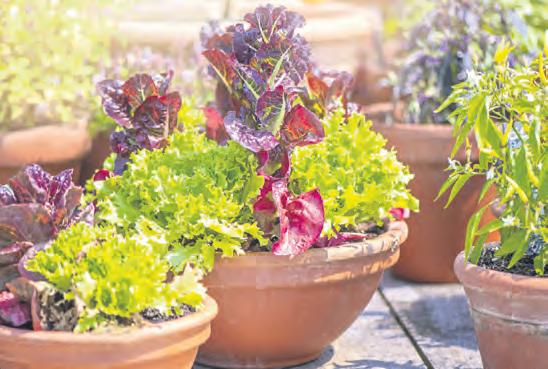
How do I know if something would be better in a pot or in the ground? I should say I am a relatively new gardener but keen to do things properly.
Katherine Laws Bristol

Peace lilies are air-purifying plants, absorbing harmful chemicals from the air. They will flower more in light shade but will also grow well in sunny spots provided they are kept out of direct sunlight. In winter, move them close to a windowsill to encourage early flowers. A temperature of around 18°C will keep them growing throughout the year but if they are kept cool you will induce a rest period. They abhor draughts so take care when positioning. Water from below to avoid splashing the leaves, which may cause spotting. Maintain high humidity by standing the plants on trays of moist pebbles or sphagnum moss.
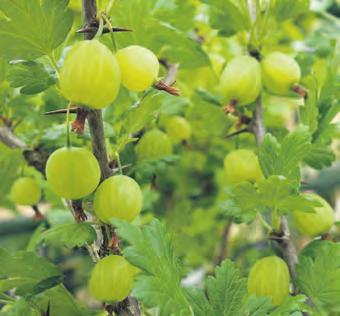
Can I move a gooseberry bush? We have clearly planted them in the wrong place.
Adrian Lancaster Exmouth
Gooseberry bushes are simple to move and should be transplanted in late winter to early spring. Dig a trench and get the spade under the rootball and lift the whole plant as cleanly out of the soil as possible. Dig a trench around and beneath the rootball and lift the gooseberry out of the ground, with as much of the rootball intact as possible.Gooseberry bushes should be planted around 1.5m apart (5ft). They fruit on older wood and on the base of young wood and can even be trained into cordons and fans against walls or fences if space is tight.
I have easy access to my neighbour’s horse manure and have often thought I should be adding it to my vegetable garden but something is holding me back. Should I be using it?
Matty Oliver BournemouthHorse manure makes an extremely good soil improver for the garden. When using horse manure, ensure it’s well rotted or composted, and at least six months old. If the horse bedding is wood-based, manure should be at least a year old to ensure the wood in it has broken down completely, otherwise it takes nitrogen (a major nutrient required by plants) from the soil. Bagged manure from manufacturers is guaranteed to be well rotted.

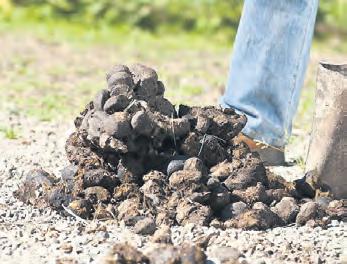
Often combined with stable bedding and allowed to rot down for a couple of years, horse manure is perfect for digging in or spreading as a mulch. Fresh manure mustn’t be used directly on the garden as it can actually remove nutrients from the soil and scorch plants, but it can be added to compost heaps.

Anything you can grow in the ground you can grow in a pot, It’s your choice. Do you have the space, the pot, the compost? If the plant is going to grow big – a pumpkin, a tree, a rosemary (a mature rosemary is a huge bush) – it will need a big pot to be happy.
Plants with lots of large, soft leaves – tomatoes, runner beans, Colocasias (taro plants), bananas, cannas, dahlias – need a lot of watering if grown in a pot (morning and evening every day in summer). Do you have the time and will for that? If not, planting in the soil might make more sense. Conversely, fine, silver leaves are a sign the plant is adapted to a hot, dry climate and won’t need to be watered in a pot quite so often. Also, if you have sticky, deep clay and want to grow Mediterranean, free-draining plants such as rosemary or thyme, pots may be the answer, as you can create the right soil conditions. Likewise, if you have deep shade from, say, a huge evergreen tree, pots may be the one way to grow something at the base of them.
Smaller, delicate plants and flowers are easier to admire in pots, but many grow more vigorously in the ground. You may want to constrain some things intentionally, or you might want to fill a space. Once it’s in the ground you can always put it in a pot, and vice versa, ideally in autumn or spring.
We have a gravel driveway and a low brick wall separating us from our next door neighbours. We would like to do something to brighten up this area but there is very little topsoil available, and it is mainly gravel. Could we plant something without having to bring in lots of soil?
Dave Melling Cheltenham
Gravel is a poor environment for growing a lot of things. Classic spring bulbs would struggle. Beth Chatto was an inspirational gardener who really invented gravel gardening and it might be worth looking up her ideas online. If there is lots of sun available in the garden then you have a few options. Allium and nerines might work. Very well suited to this sort of environment are the Mediterranean style of plantslavender, thyme, Citus ( rock rose), santolina and rosemary would all look good and you could mix with grasses.
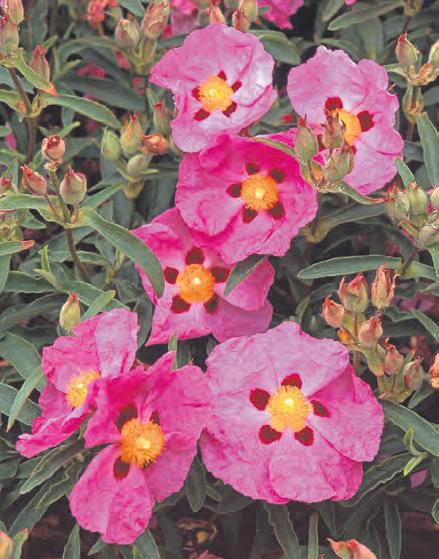
Let’s get Lilies of the Valley back in fashion

Hetty Coulson inherited her love for these woodland flowering plants but now finds herself having to defend them and see if there’s a way back into fashion for them
My mother was a real lover of lily of the valley plants.
She had Convallaria majalis, all over her Dorset cottage garden and seeing them is one of the memories of my youth. She loved their delicate bell-like flowers that produce a sweet scent I still associate with springtime and early summer.
She always thought them one of the best shade and best fragrant flowers and had them in the woodland, natural areas of her smallish garden. She loved to have them cut and in the kitchen.
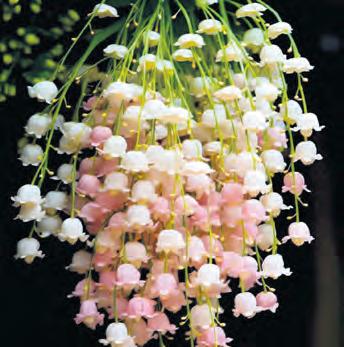
gardeners have taken against them and won ‘t plant them. Isn’t it odd how some of these things just go out of fashion!
July and the start of high summer brings with it a couple of unique things. Firstly amongst all the hard work during the long daylight hours is the chance to sit back and enjoy the garden and your efforts. It’s a time to perhaps consider what you can do to improve your outdoor living space with new furniture, extra luxuries to improve the value of your property or just the odd new fixture and fittings.
It’s also the time of year when you don’t want all that hard work in spring to go to waste and that means making sure everything is growing at full steam and flowers and shrubs are looking their best.
At Country Gardener we are always on the look out for great products and fresh ideas so here’s a few which might tempt you make the garden even more enjoyable and your home more pleasurable.
I too am fond of them mainly because of her but in recent years they seem to have fallen out of favour and I find myself having to defend and champion them.
The cry goes out that lily of the valley are invasive and poisonous and can ‘take over ‘ gardens far too easily.
This saddens me. At a recent gardening club meeting one member launched an attack on them accusing the plant of spreading wantonly and destroying native plants. Unfair and not true. True they can in some cases cause skin irritation but the ‘poison factor’ has been overplayed and only real danger if eaten and who would want to do that?
Lily of the valley is a perennial plant that for me steals the show every spring, producing small, bell-shaped white or pink flowers with a heady fragrance. It is true that with a vigorous growth habit, lily of the valley plants can spread quickly. But for heavens sake they are easy to control and their beauty far outweighs the problems. We visited an NGS garden open the other weekend just outside of Lyme Regis and the lady owner had a lovely swathe of them -delightful and she was clearly very proud of them. She too has memories of the plant from her youth and told me they were not as common as they once were and many
Lily of the valley are some of the best ground cover plants, and as such vigorous growers, you’ll quickly have a carpet of white bell-like flowers. They are woodland plants and grow best in the dappled shade under a large tree or established shrub and return year after year, and their seasonal interest is not limited to spring. The white flowers and ovate green leaves are followed by red berries in the autumn, extending interest in the garden borders up until the winter. There are some varieties that are not so invasive as others, including the pink lily of the valley, Convallaria majalis var. rosea, and the striped lily of the valley, Convallaria majalis var. Albostriata. Both of these varieties have the iconic lily of the valley blooms that open in late spring and are highly fragrant.
So, I am urging more west country gardeners to try these lovely, harmless plants which have such a history. For those wanting to try them, lily of the valley grows best in nutrient-rich soil. In its native environment, this plant grows with a rich soil from decomposing matter found on the forest floor.
I have never grown lily of the valley in pots, but it is possible I am sure. While they are not typical container plants, growing them in a pot is a good idea to reduce its spread. Use a nutrient rich potting soil and position in a partially shaded corner of the yard. Do not forget to water frequently during the spring and summer when the temperatures rise.
Growing lily of the valley is a great way to add colour and fragrance to any space or patio but be warned, just in case you find it races away and grows and spreads too quickly be sensible and plant with caution.
I don’t want it to get any more bad publicity!
“I too am fond of them… but in recent years they seem to have fallen out of favour and I find myself now having to defend and champion them.”
‘EntoGrow’ organic fertiliser comes from a Sustainable Award-winning business, recognised for their low carbon methods and organic supply chain. Their fertiliser is the pure filtered sand textured mealworm excrement and can be used for top-dressing, root drenching or adding to potting mix to encourage a free-flow of nutrients for your plants, whatever they are. Emma and Mike breed mealworms as an alternative protein source for pet food and for people who feed garden birds, poultry, reptiles and fish.
enquiries@entogrow.co.uk www.entogrow.co.uk

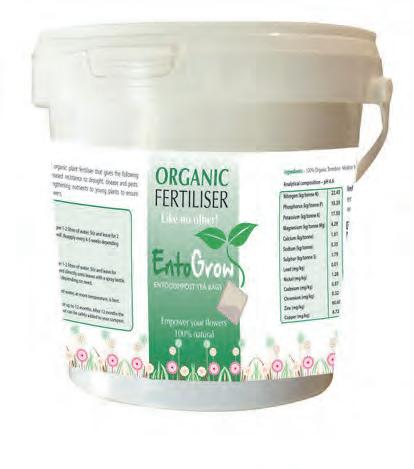
Tel: 07907 691193
Awning - now with up to 25 per-cent off*
Introducing the newAmalfi Electric Awning from Eden Verandas allowing you to enjoy alfresco evenings with dimmable lighting. Even better, the Amalfi is available with a superb finance deal. With a ‘Buy Now, Pay later ‘plus you can save up to 25percent off* in the Summer Sale. Constructed from the highest quality materials and bespoke manufactured, an Eden Awning is a stunning addition to any home. With optional accessories such as intelligent heating, lighting & controls to suit all needs you can spend more time ‘outdoors’ in comfort. Every Eden Awning is powder coated with a hard-wearing weather-proof finish, available in a choice of 150 RAL colours and 170 Fabric choices and installed by engineers. To benefit from these offers, visit edenverandas.co.uk or call 0800 157 1677 and use code CG010724. *Terms & Conditions apply, see website for details. www.edenverandas.co.uk


certified All in One fertiliser Promotes strong root growth, thicker cell walls and prolific flowering Perfect for saplings, vegetables, annuals, perennials, and houseplants! Give your plants protection naturally against pests, disease and drought!
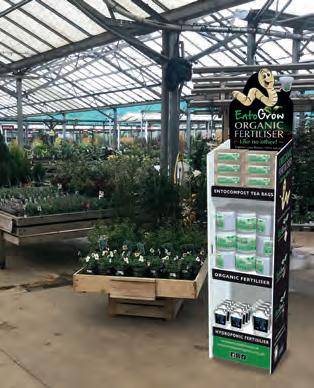











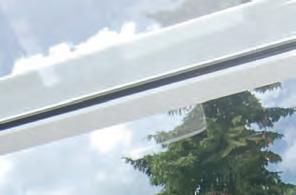






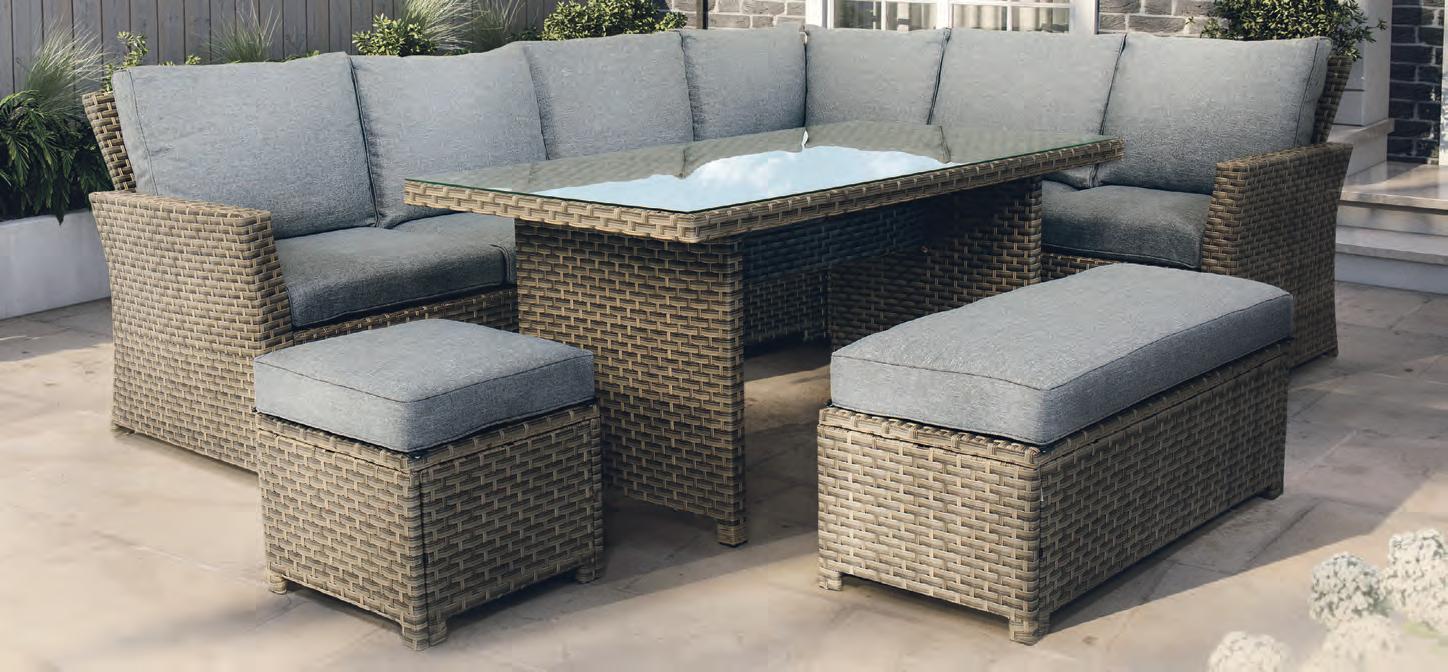
◆
◆
◆


































Extend the perfect welcome with coir
The natural material extracted from the husk of the coconut have been used for producing various household products for many years. Coir doormats are one such product made with natural, biodegradable, and eco-friendly coir bristle fibre.
Stylish and crafted with care, CoirProducts of Salike® offers an exciting range of coir doormats that help trap dirt, mud, and moisture from shoes. The coarse coir fibres provide excellent traction, making these doormats slip-resistant and safe. In addition to being quick drying, these heavy-duty doormats are also resistant to water, mould, and mildew growth. Coir is not only a natural and eco-friendly product, but is also known for its strength and toughness, making these doormats sturdy and durable. Suitable for use in a variety of spaces, CoirProducts coir doormats are available in a range of sizes and designs. Ethically produced and sourced, they can also be customised to suit individual requirements. ww.coirproducts.co.uk

DON’T MISS OUT, GET THE PALMA FOR JUST £549 AND GET AN EXTRA £20 OFF DELIVERY
Make your garden the place to be this Summer with the Palma Outdoor Lounge Set. Perfect for dining alfresco, the Palma is made from expertly woven rattan and sits on a robust powder coated steel frame with chunky comfy cushions, which have removable covers for washing to maintain that pristine look. It will seat up to 9 and comes with a matching table that has a tempered glass table top, meaning you can entertain friends and family alike. This set comes with 1 year constructional warranty giving you peace of mind.
To get your Palma Outdoor Lounge Set with an extra £20 off for delivery, visit www.outandout.com and quote code CGDEAL at checkout. Offer ends 31st July 2024
Safe and effective unique controls for shrubs and climbers
You can control your shrubs and climbers using Rivelin Glen Products uniquely designed Wire Anchors. They are quick and easy to attach to concrete posts (without drilling) to act as an ‘eye’ by threading wire through them to create a trellising system.
The Gripple Trellising System is ideal to use with the anchors as the wire does not stretch, takes up to 100kg load & has a life of up to 15 years.
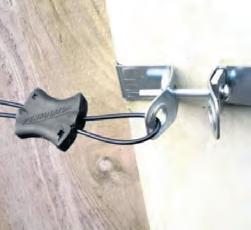
Multiple rows can be achieved with one length of wire and two tensioners. No more sore hands or sagging wires!
Rivelin Glen Products are the main stockists of the Gripple Trellising System. Prices: Wire Anchors from £10.00 for a pack of three; Gripple Starter Kit - £19.75
Details available at: www.rivelinglenproducts.com
Email: info@rivelinglenproducts.co.uk or Tel: 01246 462666


Quick & Easy Solution to fix wires to concrete posts NO DRILLING - simply clamp the two halves together
Three sizes to fit most concrete posts FREE UK DELIVERY
Main Stockists of Gripple Trellising


Visit our website to view our other gardening accessories and gift ideas

www.rivelinglenproducts.co.uk
info@rivelinglenproducts.co.uk 01246 462666
 Wire Anchor
Wire Anchor with Gripple Trellising System
Wire Anchor
Wire Anchor with Gripple Trellising System
We are always delighted to hear from Country Gardener readers sharing their views, suggestions, thoughts, ideas and gardening tips. Just email us at editorial@countrygardener.co.uk or write to us at Country Gardener, Mount House, Halse, Taunton TA4 3AD
I have just looked at the June issue of Country Gardener magazine and especially at the article about lilies. It saddens me to note there is no reference made to the dangers that these plants offer to cats. It is well documented elsewhere that all parts of the lily plant are fatally poisonous to cats - not just pollen as has been reported for several years.
Cats Protection, the UKs Leading Cat Charity, have for many years been campaigning for better labelling regarding the matter and whilst the cut flower market has responded reasonably well, the labelling of pot grown lilies and the wider information about this has been relatively poor. It has been known that the pollen free varieties of lilies have been deemed safe, but this is in fact untrue in that all parts of the plant, including water in which cut lilies have been displayed, if ingested is fatal to cats.
Kidney failure will happen very swiftly with subsequent death.

It might seem surprising advice, but if your garden is small and you don’t have children, ditch the lawn. Big borders and a reasonably-sized paved, gravelled or decked area will actually be less work than keeping a small area of grass looking good, and you won’t have to allocate precious shed space to a lawnmower. I just don’t see the point of a lawn any more . It is wasted space and so much more could be done when it has gone.
Colin Dunmore Exeter

It is still surprising to find that there are still many people who remain unaware of this risk to our feline friends, and therefore it would be great to see better coverage and reporting of the risks more widely published.
David Manners Somerset
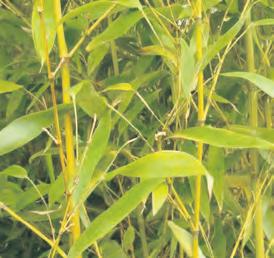
With reference to your article on bamboos I was reminded I had a conversation with a gardener who was looking to provide me with some landscaping work. I mentioned to him that we might like to put some bamboos against the far fence which might grow to provide cover. He was outraged. ‘Never plant bamboo’ he said. ‘If you do you will never see your garden again.” His passionate declaration of hatred for it has stayed with me for years and I always think of him when I see bamboos mentioned.
Brenda French ChichesterIf you shop in any major gardening retailer you'll find shelves lined with hundreds of seed packets labelled as ‘wildflowers.’ I have warning I would like to pass on –these labels are often too broad and they can lead people to accidentally plant non-native and even invasive species. There are some brands which are taking advantage and I would urge gardeners to look carefully at the labels to see what the packet contains. The genuine mixes will have details of the seeds it contains- by variety. The ones to look out for just say ‘ wildflower mixture’. I keep running into posts where people buy mixes that are labelled 'wildflower' or 'native.' This is typically just misleading marketing used to dupe people who are trying to be environmentally conscious with their landscaping.It should be illegal to be so general, but it is not.
Tobias Wells Chepstow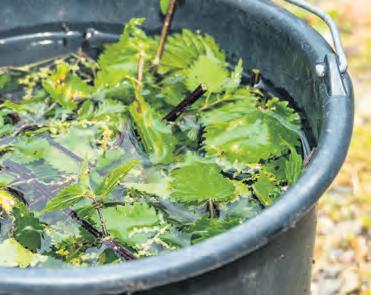
I came across an idea last year which seemed to work. I added eggshells into the soil around the roots of tomatoes as hopefully a deterrent against blossom end rot.
If you have the problem and nothing else works then it's time to give eggshells a chance to do their calcium-enhancing magic.
Chris Lewis Burnham-on-Sea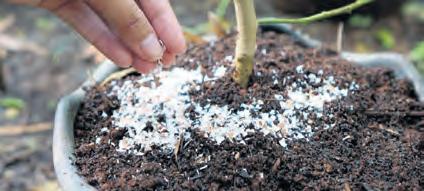

NT Overbecks a very special place
We have just returned from a wonderful afternoon at NT Overbecks, the listed garden cut into the side of the cliffs overlooking Salcombe. It was a first visit to a special garden. We were there on a sunny day in early May and the first thing that strikes you is the setting with glorious views out to sea. The garden is full of interest. It was used for rehabilitation of First World War soldiers at one stage and is not to be missed and worth the very steep climb from the Salcombe - South Sands ferry.
After recovering, the very carefully maintained gardens yield one view after another. The micro-climate is gentle so enabling delicate plants to thrive, like bananas, a Japanese garden and some that rarely flower elsewhere. The gardeners were friendly and chatty and the whole afternoon was just memorable.
Annie Pocock YeovilIf you have an allotment for vegetables or grow them in your own garden - here’s my advice. Just grow two cropsasparagus and leeks. Why do I say this -just look at the price in the shops- £8 for a small bunch of asparagus and leeks £1 each? If ever there was a reason to grow your own these prices are it.
Jonny Holmes Taunton
My father was a patient, thorough gardener and he used to tell us never to waste anything in the garden especially things like nettles. He saw this weed as full of nutrients beneficial to many crops and plants.
Rich in nitrogen, iron and potassium, nettle fertiliser was used for leafy vegetables. He used nettle feed on crops in his vegetable garden, such as kale, chard and spinach. Nitrogen was useful for these crops as it increases leaf growth, which is ideal for those seeking plenty of salads and leafy veg this summer.
His recipe was to put nettle cuttings in a bucket and fill it with water to cover the nettles. After four weeks, the nettle fertiliser was ready to use for leafy crops. He would dilute one part nettle feed to ten parts water, keeping the solution covered up when not in use. This liquid can be used as a foliar spray to deter common garden pests, such as aphids and mites.
Nick Davis Portsmouth




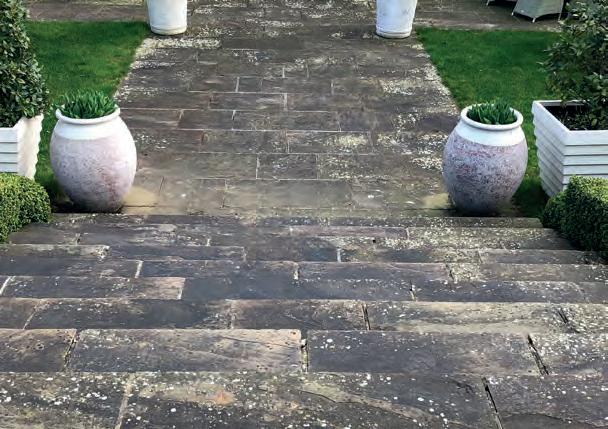

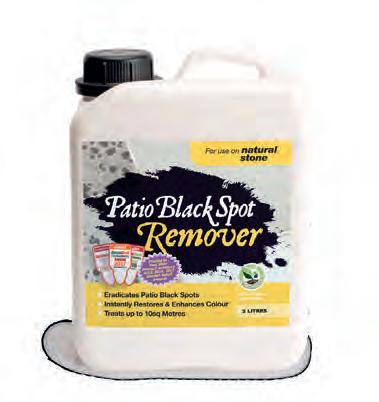
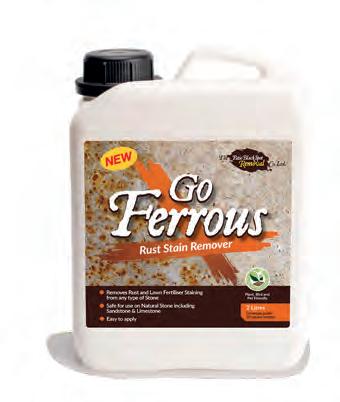


It’s high summer, and time to get away from your chores to spend a few relaxed hours in someone else’s lovely garden, enjoying a cuppa and cake while helping to raise much needed funds for nursing and caring charities. Here’s a selection in the areas covered by Country Gardener. Visitors are advised to check with the gardens before travelling.

Solsbury Lane, Batheaston, Bath, Avon BA1 7HB
Opens for the NGS on Saturday 13th and Sunday 14th July, 10.30am4.30pm each day, two acres of south facing gardens with 1/3 acre devoted to cut flowers and foliage, a colourful mix of annuals, biennials and perennials. Spectacular views from terraced lawns, box parterre, small orchard and meadow area. Admission £5, children free.
Westhill Lane, Bason Bridge, Highbridge, Somerset TA9 4RF
Opens for the National Garden Scheme on Saturday 13th and Sunday 14th July, 2pm-5pm, a 1½ acre plantsman’s garden on the Somerset Levels, with attractive vistas, gradually created out of fields surrounding an old farmhouse over the last 30 years and still being developed. Trees, shrubs and herbaceous perennials planted with an eye for form and shape in big flowing borders. Admission £8, children free.
North Street, South Petherton, Somerset TA13 5DA
A new opening for the National Garden Scheme on Sunday 7th July, 11am-5pm, a lovely ten-acre garden with glorious views over the surrounding countryside, with formal planting, water and wildlife areas, kitchen garden and greenhouse, soft fruits and large orchard. Over 1,000 trees set within the extensive lawns, and seven lakes and ponds. Seating areas throughout the gardens and on the beautiful terraces. Admission £7, children free.
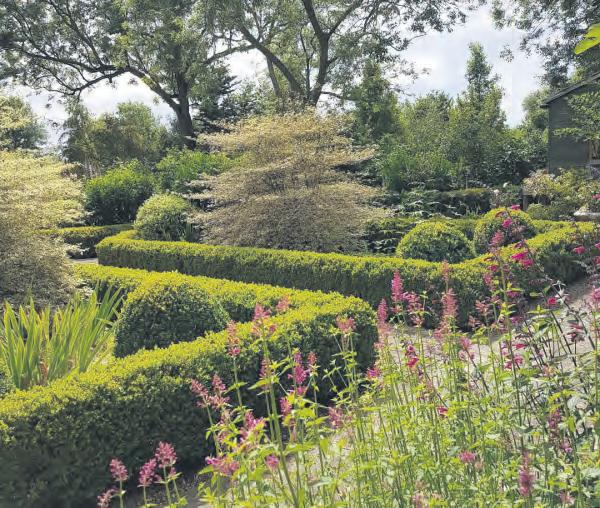
St Giles-on-the-Heath, Launceston, Devon PL15 9SL
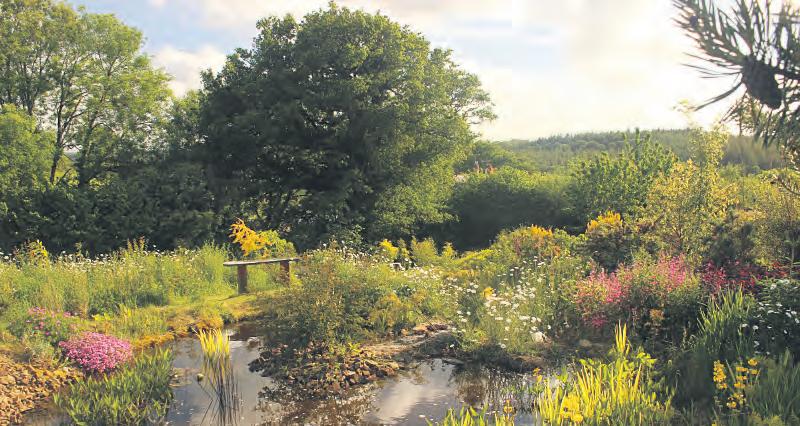
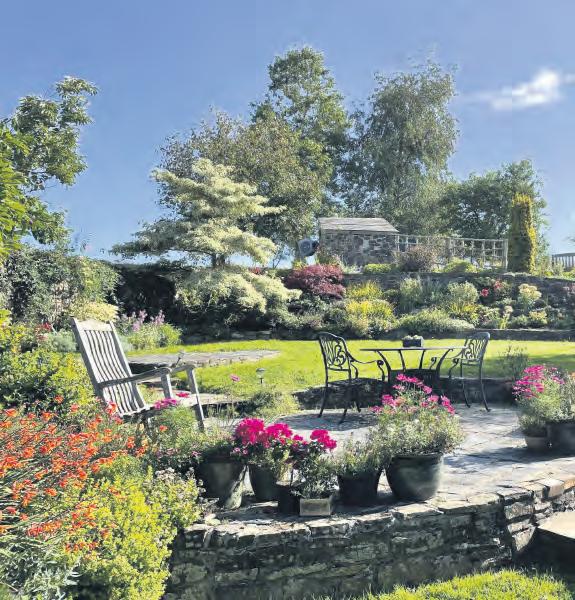
A new opening for the NGS on Saturday 27th and Sunday 28th July, 10am-4pm each day, a ‘work in progress’ set in beautiful countryside with expansive views across farmland to Dartmoor, with old and new beds, new planting reflecting the changing climate, small orchard, vegetable garden and new woodland walk and wildflower areas. Admission £6.50, children free.

Sheepwash, Beaworthy, Devon EX21 5PE
Opens for the NGS on Friday 19th, Saturday 20th and Sunday 21st July, 11am-4.30pm, a one-acre naturalistic/wildlife/ plantsman’s/sensory garden on sloping site, with rare and unusual plants, 13 ponds (koi, lilies), stream, Japanese garden, Mediterranean garden, wildflower meadow, ericaceous plants including rhododendrons, acers, hydrangeas; grasses/bamboo - and there’s clock golf too! Admission £5, children free.
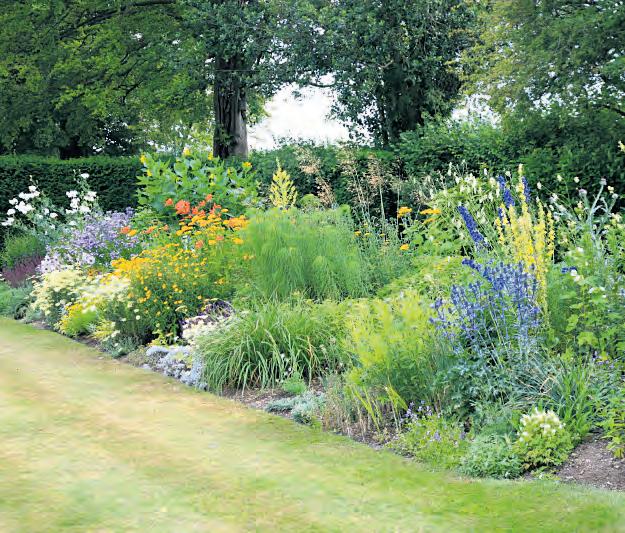
Crawley, Winchester, Hampshire SO21 2QB
Opening for the NGS on Sunday 7th, Thursday 18th and Sunday 21st July, 2pm-5.30pm each day, the half acre garden has a Monet-inspired rose arch and small wildlife pond, a Victorian boundary wall with trained fruit trees, a raised lily pond, colourful herbaceous bed, herb wheel, large productive kitchen garden and unusual flowering plants; a two-acre field with views over the Hampshire countryside has been made into walk-through spring and summer wildflower meadows. Admission £5, children free.

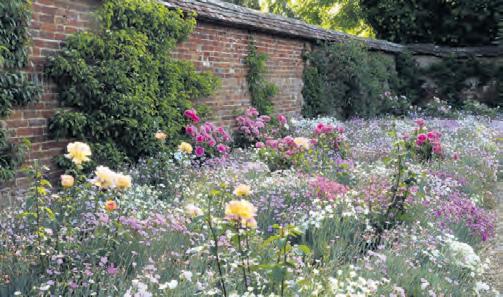
Cranborne, Dorset BH21 5PP
Opening for the NGS on Saturday 6th July, 9.30am-5pm, the beautiful and historic garden laid out in the 17th century by John Tradescant and enlarged in the 20th century, features several gardens surrounded by walls and yew hedges: blue and white garden, cottage style and mount gardens, water and wild garden. Many interesting plants, with fine trees and avenues. Admission £6.50, children £1.


Southsea, Portsmouth, Hampshire PO4 0PR
Three town gardens opening for the NGS on Saturday 13th July, 2pm-5.30pm, in adjacent roads within easy walking distance, off St Ronan’s Road. Victorian houses (not open) with peaceful green spaces about 700 metres from Southsea promenade. 35 and 67 Gains Road are small gardens designed and planted with artistic flair, including ferns, bamboo and sculpture. 28 St Ronan’s Avenue is divided into different areas including a wildflower meadow and pond, agaves and echeverias in drier sandy parts. Recycled items are used to create sculptures.

Badgeworth, Cheltenham, Gloucestershire GL51 4UL
A new opening for the NGS on Sunday 7th July, 1.30pm-4.30pm, Badgeworth Manor gardens are a stunning arrangement with a quaint knot garden, two manicured lawns, ornamental raised flower beds, two beautiful ponds, one of which is bordered by beds of roses and two Judas Trees, beautifully accented by topiary and lavender. Admission £5, children free.
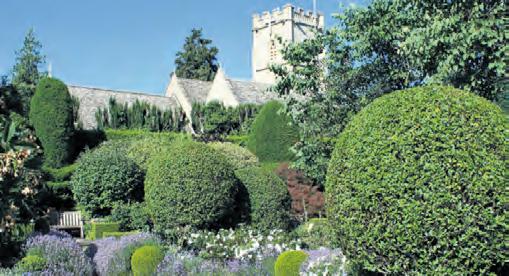

Forder Lane, Bishopsteignton, Teignmouth, Devon TQ14 9SL
A new opening for the NGS on Saturday 27th and Sunday 28th July, 11am-5pm, a ¾ acre garden full of history boasting an impressive collection of trees and shrubs with a large sloping lawn, an ever evolving space designed for wildlife and year-round interest, newly installed wildlife pond, herbaceous perennial beds and lavender border. Admission £5, children free.
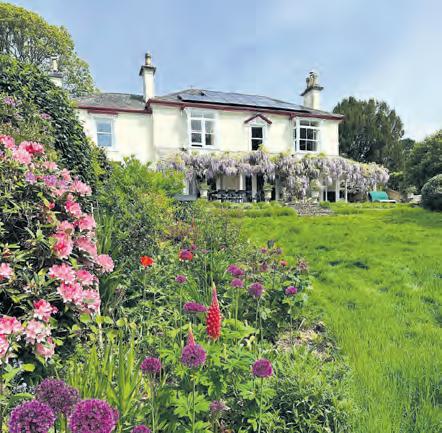
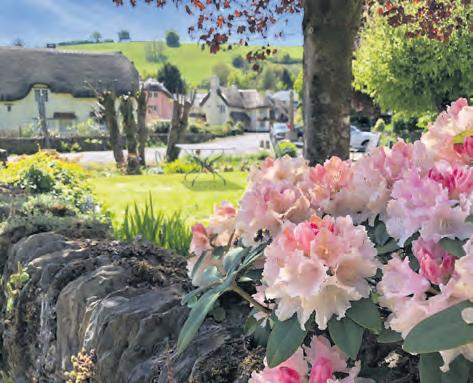
Exford Road, Winsford Somerset TA24 7JL
Opening for St Margaret’s Hospice Care on Saturday 6th July from 11am until 4pm, ten diverse gardens in the village at the heart of Exmoor, from charming cottage gardens adorned with roses to wild and natural sanctuaries.
Visit the village hall for maps and additional details, and homemade refreshments. Combined admission £5. www.st-margarets-hospice.org.uk

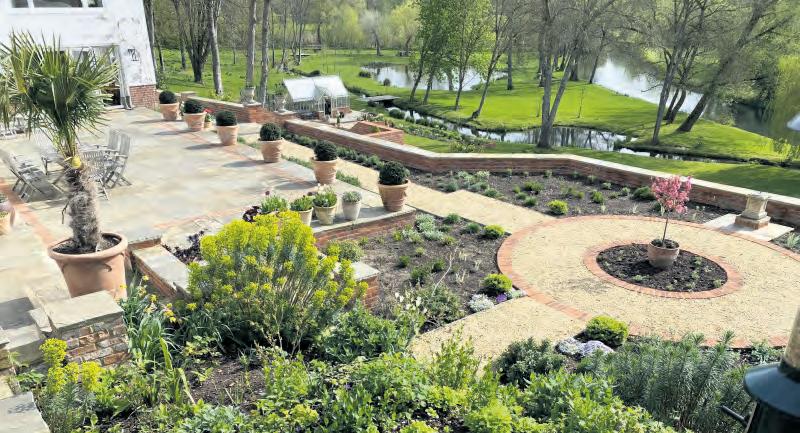
Amesbury, Salisbury, Wiltshire SP4 7BL
Opening for the NGS on Sunday 7th July, 11am until 5pm, a garden that’s been extensively developed since 2020 with 11 acres including long herbaceous borders, a lake and a half mile riverside walk. Recently added potager, shrub border, hoggin pathways through orchard to fruit store, Monet-inspired bridge, duck house on small pond, water lilies, specimen trees, chess pavilion and croquet lawn. Teas on upper terrace with magnificent views of the garden and river. Admission £7, children free.
West Knoyle, Mere, Wiltshire BA12 6AJ
Opening on Sunday 14th July for the NGS from 2pm until 5pm, The garden is south facing surrounded by hedges protecting it from the exposure of a high wide open landscape beyond, laid out with gravel to encourage a self-seeding natural look but also roses and herbaceous perennials, and topiary; beyond, a larger area of lawn and trees; large conservatory greenhouse with mature Muscat grapevine and pelargoniums. Small vegetable garden. Admission £5, children free.
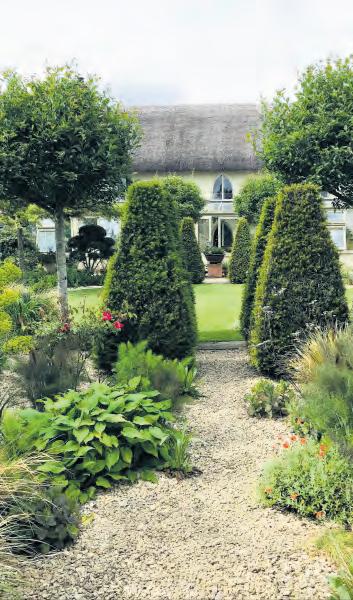
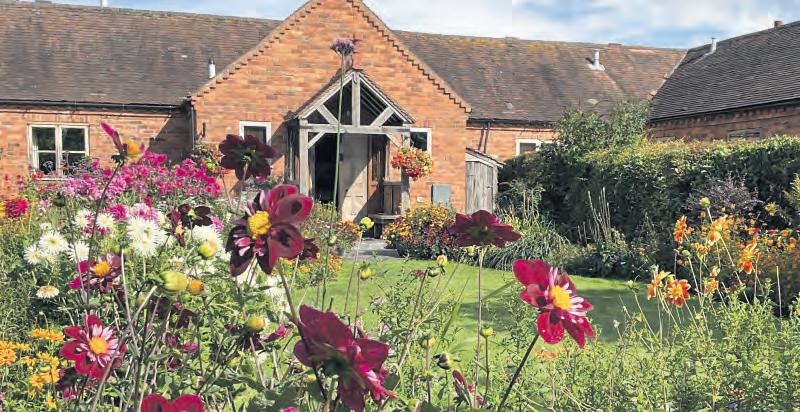
Southnett, Mamble, Kidderminster, Worcestershire DY14 9JT
Opening for the NGS on Saturday 27th July, 11am-4pm, with wonderful views of the surrounding countryside, planted out with a wide variety of trees and shrubs providing year-round interest, herbaceous beds filled with a riot of colour, two ponds, a bog garden including a stumpery, rose bed, gravel garden, two azalea beds and a small woodland area.
Admission £5, children free.
Avon Dassett, Warwickshire CV47 2AH
Opening for the NGS as part of Avon Dassett gardens on Sunday 7th July, 2pm-6pm, a two-acre mature garden built into the side of the hill, with a colourful front terrace and pretty back courtyard from which wide stone steps lead to a fountain and small wood. Many places to sit surrounding the listed house (not open) mentioned in the Domesday Book. Entrance to church through the walled garden. Combined admission £7, children free.
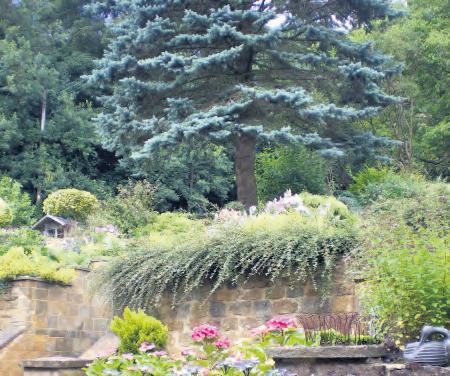
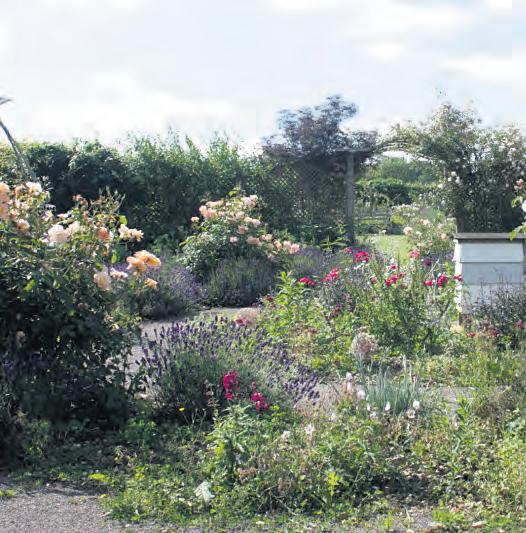
Southleigh, Colyton, Devon EX24 6JF
Opens for Hospiscare on Saturday 27th July from 10am until 4pm, a garden for all pollinators, exuberantly planted with perennials, annuals, roses, climbers and shrubs, beds and borders, herb garden, vegetable garden and polytunnel, apple, pear and plum orchards providing blossom for the pollinators and fruit for the farm’s pies, cakes and preserves, and a wildflower meadow of around 20 acres with paths and honeybees in their enclosure at the centre. Admission by donation. www.hospiscare.co.uk
Botley Road, West End, Southampton, Hampshire SO30 3JB
A new opening for the NGS on Saturday 6th and Sunday July, 1pm-4pm each day. The gardens at Mountbatten Hospice are tended by dedicated volunteers - a mixture of shrubs, ornamental grasses, annual and perennial flowers with several bug houses. Lawn areas where patients, visitors and staff can enjoy social connections and quiet contemplation, with some grass left uncut for wildlife and flowers to flourish together with pollinators. Admission by donation.

Taunton allotment holder Simon Whyte has seen gardeners come and go but says too many have failed to help their plants grow well with proper use of organic fertilisers
I have been working my Somerset allotment for over 25 years now and have seen a lot of gardeners on the plot come and go. Some are never serious about having an allotment. Others see it as a social thing inviting mates round but thankfully there are a few of us who are the real ‘pro’s’.
I can spot them because they all know the secret to gardening which in my opinion is all to do with the help we give to plants. An author friend of mine put it rather well. He said every gardener knows about and appreciates how importing feeding plants is, but few actually do anything about it. He likened it to children cleaning their teeth; they all know it must be done and what happens if they don’t do it, but most think it’s too much bother and not worth the trouble.
The fact is if you were to look at most of the vegetables grown in our gardens they are nothing like what they should do. That’s because of what I call the ‘stick it in the ground and see what happens approach’.
Yes, you will get things to grow but not as they should and could. That’s where feeding the plants, the soil, the foliage comes in.
I garden organically. So organic fertilisers contain less plant foods. This means more needs to be applied but it also makes them safer to use and it’s harder to overdose them. Their nutrients are normally slower to become available but are released over a longer period. Inorganics work faster certainly but that isn’t everything! One thing you can be sure of is that the plants can’t tell the difference.
All have to be broken down by the soil micro-orgasms so they can be absorbed by the roots. So if we accept we must help the plants with fertilisers what suits what plants? Dry fertilisers are the most convenient to use- you just open the pack and sprinkle on the ground. When the soil is dry, watering helps to speed up the fertiliser’s action. I just apply only a base dressing before sowing or planting to quick growing crops like lettuces, other salads and then follow with a top dressing for vegetables which crop for a longer time - French beans, runner beans and peas for example.
If plants need feeding during periods of drought -and many will -the answer lies in the use of liquid feeds which serve the double purpose of supplying both water and nutrients because the nutrients are already in a dissolved state. They have the benefit of being quickly taken up by the plants.
Sadly there is a downside to liquid feeds. As they are readily soluble they are also soon used up or washed out of the soil and need to be replaced more than dry fertilisers. The speed of the disappearance depends on such things as the type of soil and the rain. Generally, the only way to get round this is to apply the feed every three to four weeks.
Finally there’s foliage feeds and if you want a quick response a foliar feed such as seaweed extract should be used. The elements in the feed are easily absorbed by the leaves as well as the roots and because the material is sprayed on to the leaves the response is almost immediate.
Plant nutrition I am sure is a very complicated science, but I don’t need to know the whys and wherefores of it all because Mother Nature knows better. But a bad gardener or one who fails to feed his plants properly will soon find out what the limits are to successful growing.

DAINTY LOOKING, EASY TO GROW FLOWERS OF ANNUAL LOBELIA ARE USED TO GREAT EFFECT BY GARDENERS AS FILLERS AND SPILLERS IN BEDS, BORDERS, HANGING BASKETS AND CONTAINER

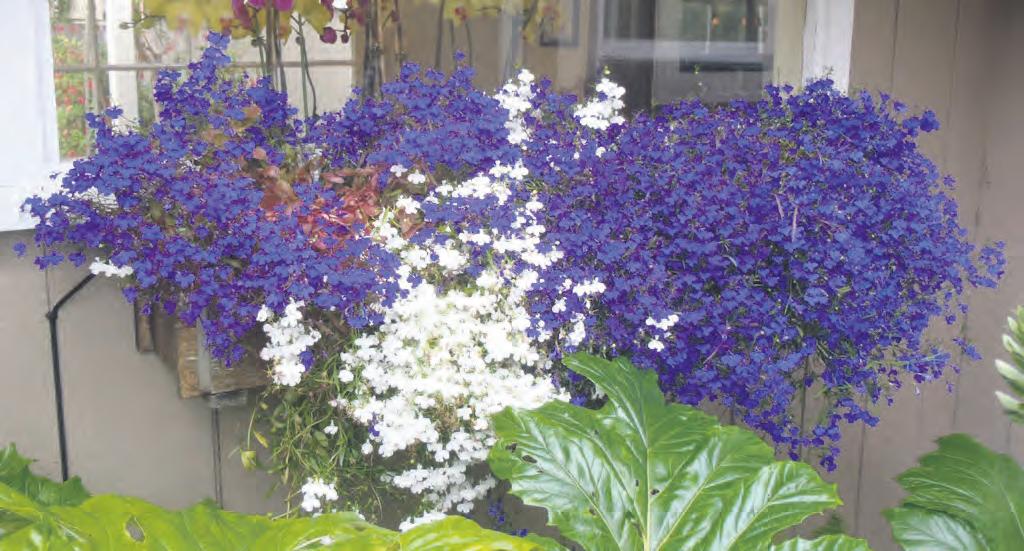
Lobelias are probably best known as those bright blue bedding plants that spill over the edges of containers and hanging baskets in high summer.
These half-hardy annual lobelias that hail from South Africa, are called Lobelia erinus. Some varieties are compact and upright, while others trail. The small, lipped flowers are mostly in shades of blue, but purple, pink and white-flowered types are also available.
There are perennial types of lobelia, too.
The best known is Lobelia cardinalis, known as the cardinal flower or bog sage.
A native American wildflower that is found growing in damp areas, it has bright red flowers that bring a splash of colour to the garden from late summer into autumn. As its name suggests, it likes very moist soil and is suitable for a reliably moist border, bog garden or pond edge.
Perennial lobelias can be short-lived plants, and are often treated as annuals or biennials. Their milky sap can irritate skin so make sure you wear gloves when handling.
Since the perennial flowers are native to marshlands, it is imperative that the soil of container grown lobelia plants is not allowed to dry completely. These plants require consistent moisture, but they do not grow well when overwatered or when containers have become waterlogged.
Bedding lobelia plants should be planted out at the end of May or early June, after the fear of any frosts. If you have a greenhouse or other protected growing area, you can plant up containers and hanging baskets earlier for the plants to grow on and so flower earlier, before putting outside in early summer. There are many types of lobelia. Some are annuals and some are perennials and some are annuals only in northern climates. Annuals will usually self-seed and come back next year while perennials will re-sprout from the dormant plant in spring.
For the most part, lobelia isn’t too picky about sunlight and can thrive in shade to full sun locations.
Lobelia likes rich, well-drained soil. Don’t let conditions get soggy, however, which can cause root rot.
Keep the soil evenly moist, but not soggy. In areas with regular rainfall, you might not need to provide extra water. In drier areas, however, be prepared to water your lobelia every few days through the summer, and more often if the weather is exceptionally hot.
Annual lobelia does best in moderate temperatures and with moderate humidity. However, it can thrive even outside those conditions if you provide a little extra care. In hot climates, planting lobelia where it will be protected from the peak afternoon sun can help prevent scorch or plant death. Regular watering will help maintain enough humidity for the plant to do well, but in very dry conditions, the leaves might shrivel. If you take quick action with the hose or watering can, often the plant will revive.
Annual lobelia will not survive freezing temperatures and is generally discarded in the winter.
Since lobelia is a prolific bloomer and heavy feeder, you’ll get the best results by fertilising it every two weeks with a liquid fertiliser formulated for flowering plants. These typically are somewhat higher in phosphorus than in nitrogen and potassium, as phosphorus promotes more flowers.
Mix the fertiliser with water in a watering can according to package directions, and apply it to the base of the plant, avoiding its leaves. Continue to fertilise your lobelia regularly through the summer to keep it flowering.
Andrew Lancaster is a weather historian and lover of folklore. He is also a passionate gardener and looks at the ‘maturing weather’ in July.
My father- a real countryman and a man steeped in weather folklore always welcomed July because he thought it brought some ‘mature weather’.
He saw it as a quiet month- the flurry, excitement and blossom extravaganzas of spring and early summer were past and I understood what he meant about the maturing of the weather. The thrill of early summer had gone and the harvest of autumn still to come. For the gardener it can be something of an in between month. Everything is growing but not a lot ready to pick, harvest and enjoy. Even the birds perhaps enjoy a quieter few weekstheir eggs laid and hatched.
July can be been dominated largely by low pressure across the UK and Ireland with weather pattern has changed mainly due to a change in the jet stream.
The jet stream is a fast-flowing, meandering band of air, stationed 30,000 feet high in the atmosphere and blowing west to east across the Earth. It is the result of a large temperature gradient between the northern and southern hemisphere.
The most famous of weather lore for July - perhaps even for the whole year - relates to 15th July, St Swithin’s Day.
St Swithin or Swithun was Bishop of Winchester and he died in AD 862. He was adopted as the patron saint of Winchester and in the 12th century the doggerel lines were penned. “St Swithin’s Day if thou dost rain For forty days it will remain St Swithin’s Day if thou be fair For forty days will rain na mair”.
There is some reason for this to be valid.
Over high summer the weather in the UK tends to be locked into a pattern so whatever that is on 15th July could be around for a few weeks even in some cases through to the end of August when autumnal weather begins.
Incidentally, rain on St Swithin’s Day is supposed to bless the apples and ensure a fine
Some weather folklore which has been around for thousands of years is the idea of the ‘dog days’, the hottest, muggiest days of summer -normally in July but often tipping into August. The name comes from the heliacal rising of Sirius, the dog star and the brightest star in the sky. Heliacal rising is the moment a star first becomes visible pre-dawn in the east. In ancient Rome and Greece it was thought to be a time of bad tempers, bad luck and general unrest due to the oppressive heat. In Britain it was seen as a time of dry weather and perfect for the harvest.

“Dog days bright and clear indicate a happy year,
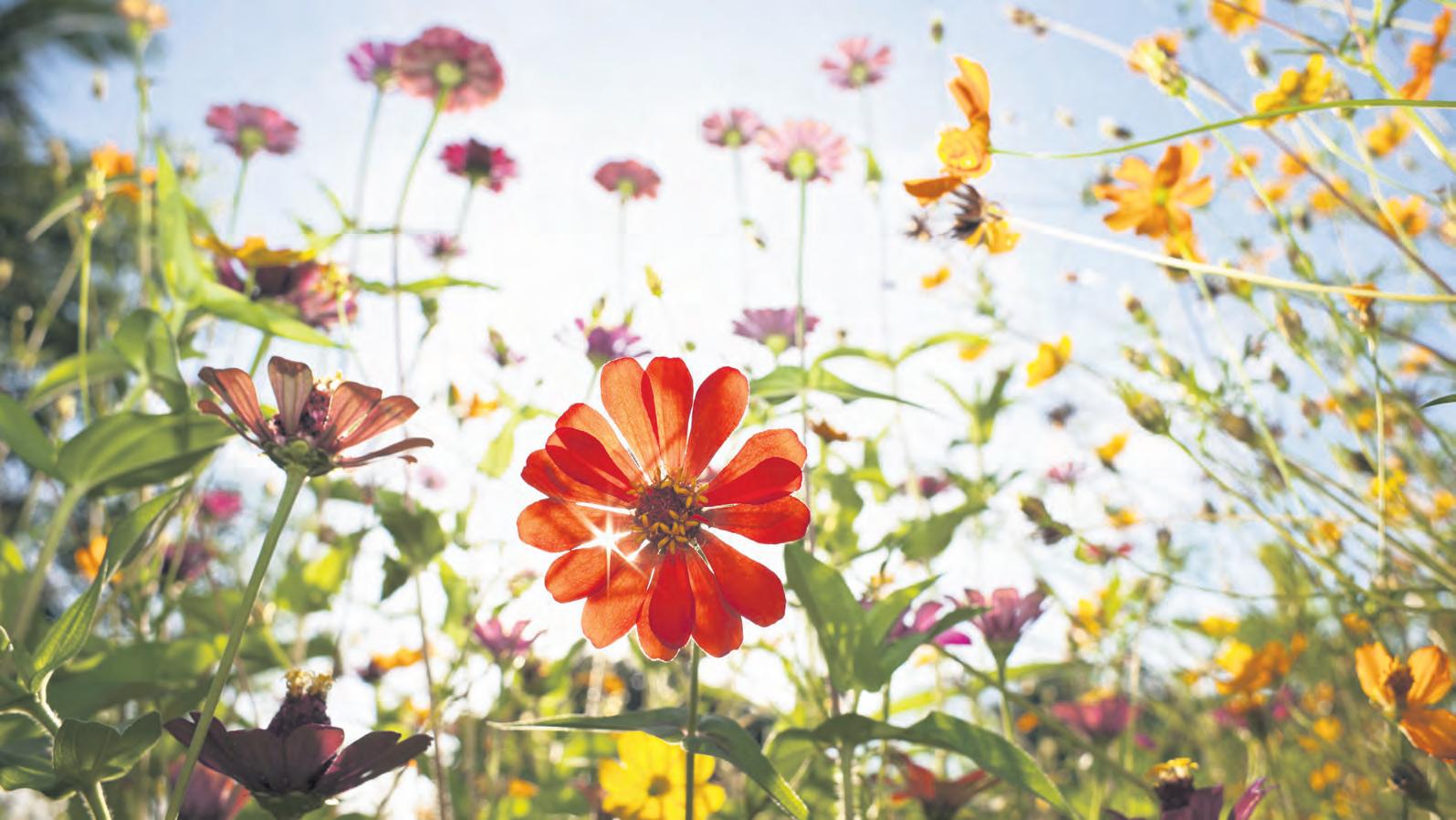

In July many of us gardeners love supporting the wildlife in our gardens as much as tending our plants.
With verdant hedgerows, the hum of insects, warmer days and milder nights, summer is in full swing.
Midsummer is when the sounds of nature change. Birds sing less often but we hear the voices of many insects, from the drone of bees to the stridulations of grasshoppers. It’s the time of grassland butterflies and seedladen grasses waving in the wind.
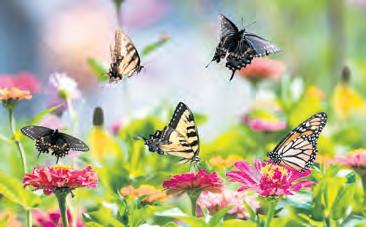

Our popular gardening themed crossword is compiled by Saranda which over the past year has become enormously popular with readers. The winning entry to be drawn by us will receive £100 of RHS gift tokens. Completed entries should be sent to Mount House, Halse, Taunton, Somerset TA4 3AD. Closing date Friday 19th July. The May issue winner was Nick Howe from Bideford.
Dehydration can be a huge issue for wildlife in summer, especially in times of drought or heatwaves. Natural water sources may dry up and juicy worms and insects are harder for birds and hedgehogs to reach in dry solid ground. There is a stillness to July. The peak of energy the world felt in June is fading and there can be a sense of pause,
In July some bee species begin nesting – solitary leafcutter bees will start nesting in boxes and bumblebees build up their colonies in boxes. You may notice a drop in visibility of honeybees this month after their spring and early summer activity.
Bats are most active in the summer when they come out of hibernation. However if you are lucky, on some summer evenings as the sun sets bats can be seen performing flying acrobats in their hunt for insects in our gardens. Dusk in July is an eventful time to be watching our wildlife in the garden.
In July, as the ground gets harder it gets more difficult for birds to source worms so competition for food sources gets more intense. They also have a real need for extra water to stay hydrated and maintain a cool body temperature. Some birds may still be nesting, so be wary of this when planning any pruning.
Towards the end of the month, you may experience a decline in bird numbers, generally timed with the increase in wild berries available elsewhere or as they disappear to moult.
As the weather warms, our summer butterfly species can be seen in gardens and July is often a peak month. Big Butterfly Count begins in July, running through to August. Join in and help record the state of our nation’s species. Butterflies you are most likely to spot include Brimstone, Comma, Peacock, Red Admiral, Small Tortoiseshell, Painted Lady, Large White, Common Blue and Speckled Wood.
Moths who are often overshadowed by butterflies also play a significant role in pollination, in fact they pollinate more efficiently than bees! At night using their long proboscis they reach deep into the blooming flowers and extract their nectar inadvertently transferring pollen from one flower to another.
July is the middle of the breeding season for UK hedgehogs, with hoglets predominantly born in June and July. Nests need to be left in peace at this time as a disturbed female hedgehog may abandon her babies.
ACROSS
1. Genus to which the wallflower belongs (8) 6. Split-leaf philodendron or Monstera deliciosa (6, 5)
13. Arctic-alpine plant, Dryas octopetala (8, 5)
14. Rhamnus purshiana, and also Spanish for peel (7)
15. Australian five-cent piece (slang) (4)
16. A highly regarded British apple (4, 6, 6)
18. The commander of a fleet in ancient Greece (7)
19. Vegetation of pasture land (7)
21. In heraldry, a purple roundel (5)
23. The fruit of Capsicum annum (8, 6)
24. Vegetable from the Belgian capital? (6)
26. This happens when the Devil drives? (5, 4)
28. An arm of the Mediterranean between Greece and Turkey (6, 3)
30. Genus of South African plants known as sugarbushes (6)
31. 1993 Spielberg film starring Liam Neeson (10, 4)
34. A moderate member of the German Green Party (5)
35. Person who encourages someone to do wrong? (7)
36. Costmary or bible leaf (7)
38. Common name of Lotus corniculatus (9, 7)
41. Sir Tim ____ helped create the Lost Gardens of Heligan (4)
43. Native of Ljubljana (7)
44. Someone who lends an ear sympathetically (1, 4, 8)
45. Not considered with suspicion (11)
46. Certain grass cutters? (8)
DOWN
2. Variety of large pea (8)
3. Bristle-like appendage in some plants (4)
4. The most important bridesmaid at a wedding (4, 2, 6)
5. Intends (5)
6. Ready to eat like a certain fruit (6, 4)
7. Important German city in the Ruhr valley (5)
8. Having stems growing out of the roots (8)
9. Be dead and buried florally! (7, 2, 7)
10. Having no carpels (11)
11. To cause a plant to grow in a particular direction (5)
12. South American flower (6)
17. Absurdity (16)
19. Class of plants that comprises liverworts (9)
20. _________ Anderson (1748-1811), Scottish botanist (9)
22. A natural preparation taken from a plant (7)
23. Main botanical in gin (7)
25. Affability or good-naturedness (12)
27. People involved in preventing environmental damage (3-8)
29. Common name of West Indian tree Picrasma excelsa (10)
32. Someone who collected ironstone rock for foundry use (4, 5)
33. Orange or red pigment found in plants (8)
37. New Zealand conifer which yields valuable timber (6)
38. Palm tree, Manicaria saccifera (5)
39. Australian tree, Eucalyptus gomphocephala (5)
40. Withers like a flower (5)
42. ____weed or stinging nettle (4)
ACCOMMODATION
Secluded cosy cabins & lodges in wooded valley running down to Wembury Bay & SW Coastal Path

Plymouth, Dartmoor & lovely South Devon Villages & Towns in easy reach. Pets Welcome. Forest School. Tel: 01752 862382 www.churchwoodvalley.com
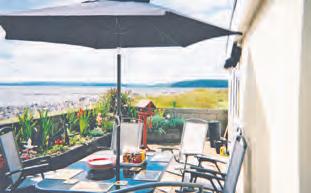
Carmarthen Bay South Wales Seafront chalet situated on estuary. Sleeps up to 6. Seaview. Well Behaved Dogs Welcome Free of Charge. Free WIFI. Open from 1st March - 31st Dec. For Brochure Tel: 01269 862191
GLORIOUS NORTH DEVON. Only 9 cosy caravans on peaceful farm. Wonderful walks in woods & meadows. Easy reach sea, moors & lovely days out. £125-395pw. Discount couples. Nice pets welcome. 01769 540366 www.snapdown.co.uk
BOSWORLAS, ST JUST.
Cosy Cottage sleeps 2-4. Please email info@bosworlas.co.uk for availability
ACCOMMODATION HOLIDAY COTTAGES
WYE VALLEY/FOREST OF DEAN. Fully equipped single-storey cottage with two en-suite bedrooms. Wi-fi.Recently awarded Visit England 4-star GOLD. Rural retreat, shops/pubs one mile. Enquiries welcome. AS SEEN ON ESCAPE TO THE COUNTRY! Tel: 01594 833259 www.cowshedcottage.co.uk
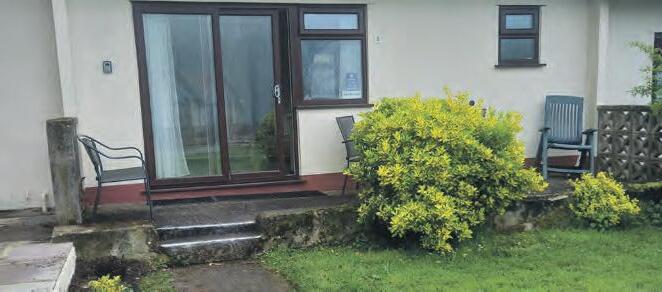
COTTAGE SIDMOUTH, DEVON
A quiet holiday bungalow near Sidmouth, overlooking the Donkey Sanctuary. Ideal for walkers and nature lovers. Sleeps 4. Bookings from April to the end of October.
jandtmercer@gmail.com
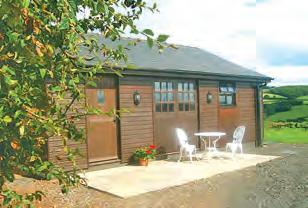
Peace, Privacy, and Stunning Views!
4* Delightful cosy cabin for 2, nestling between Wye and Usk Valleys. Shirenewton village & pubs close by. Wonderful walks, splendid castles, bustling market towns. Perfect for all seasons!
Tel: 01291 641826
Email: lynne@bryncosyn.co.uk www.bryncosyn.co.uk
ACCOMMODATION WITH BEAUTIFUL GARDENS
NORTH DEVON NEAR CLOVELLY. 3 delightful cottages situated in 12 acres of idyllic countryside. Sleeps 2-4. 1 Wheelchair friendly. Brochure: 01237 431324 www.foxwoodlodge.co.uk foxwoodlodge@outlook.com
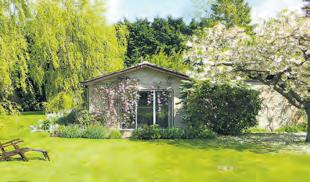
Near Stratford-upon-Avon
Lovely self-catering cottage in peaceful location: large garden. Sleeps 2. Perfect for famous gardens, NT properties & Cotswolds. Tel: 01789 740360 www.romanacres.com


Gloucestershire Quality Bungalow B&B
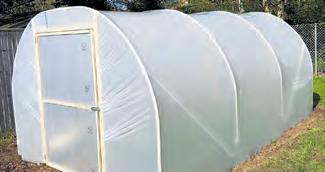
REACH 300,000* LOYAL READERS WITH Classified advertising classified@countrygardener.co.uk

A range of over 200 greetings cards and prints from the flower paintings of ANNE COTTERILL We sell to both individuals and trade. No order too small. Contact us for your free catalogue.
Mill House Fine Art Publishing, Bellflower Gallery, Market Place, Colyton, Devon EX24 6JS
Tel. 01297 553100 info@millhousefineart.com www.millhousefineart.com

THE GARDENER’S BLACKSMITH jonne@jonne.co.uk 07770 720 373
Artist blacksmith based near Axminster designing and manufacturing garden plant supports, structures, garden art and fine art bronzes. Commissions welcomed. www.thegardenersblacksmith.co.uk



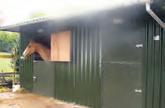



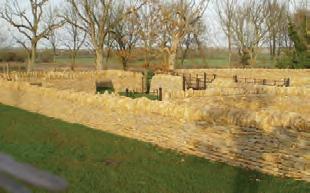
Ensuites, rural, large garden, paddocks, sheep and fruit. Ideal Cotswolds, Malvern’s, Forest of Dean, cycle storage, ample parking, Wi-Fi £42 p.p.p.n. Tel: 01452 840224 sheila.barnfield1960@gmail.com Yenstone Walling
Dry Stone Walling and Landscaping
Patrick Houchen - DSWA member Tel: 01963 371123 www.yenstonewalling.co.uk
1:1 GARDENING ADVICE SESSIONS. Experienced RHS Qualified Gardener. Malvern (01684) 594266 jane.cotswoldgardener@hotmail.com






Ruth Goudy admires the work and style of artist Bella Hoare whose paintings have a history in NT Stourhead in Wiltshire in forests and woodlands all created in the hue of nature
An art exhibition based on the time artist Bella Hoare spent in the forest and woodlands around the Stourhead Estate in Wiltshire has been wowing visitors with their unique greenness.
The pictures– intrinsically linked to celebrate nature and its ability to nurture and empower are all created in a green hue and her subjects all women.
In May and June this year Bella Hoare hosted an exhibition at the Oxo Tower, London. Bella is a descendent of Henry Hoare, who created the Stourhead Estate and Gardens, Wiltshire, now run by the National Trust. Bella grew up on the estate and now lives beside it, in Gaspar Cottage, working in a purposebuilt studio looking over the valley.
The pictures in the gallery are testament to the time she has spent outdoors in the forest and woodlands around the garden and how she believes that nature is a powerful source to tap into.
Somehow, as you gaze at the paintings the green hue becomes lost. The women simply absorbed and reflected back the green of the forest around them.
A particularly striking two metre high painting is ‘Cradled’ where a naked, pregnant lady sits on a tree stump cradling the baby in her belly. Surrounding her is lush vegetation, ferns, birch trees and a body of water. It feels that the lake and surroundings at Stourhead are ever present. Bella explained that she wanted to give the sense that the forest is, in turn, cradling the woman and her child.
Bella takes this idea of a nurturing forest further when she explores the theme of the green goddess within some of her paintings at the exhibition. She laughed when she described how she likes men but was always curious as to why the pagan Green Man had to be a man. Still using green shades she surrounds feminine faces, old and young with different foliage. The textures and colours blend and merge and you find yourself drawn into the eyes of the creature before you, perhaps becoming a little entranced. Instead of being young or old they appear timeless, rather like the woods and trees.
Bella Hoare is open about how she believes that nature, green places, forests and gardens are healing and how she has found that their seasonal cycles ‘sustain and enrich’ her. She described how much those places and seasons had helped to give a sense of renewal during her times of hardship. She wanted the exhibition share that and to be a celebration of feminine beauty and power. Her choice of subject for her next series of paintings was five women who are part of the ‘Glasshouse Project’. The project has become familiar recently, since their garden won a gold medal at Chelsea Flower Show and were featured on BBC Gardeners World. What is inspiring is that the whole project has evolved out of a disused glass house in a women’s prison. It was originally set up to use nature to help prisoners to thrive by propagating plants and teaching horticulture to women. Once the women leave prison they are invited to join employment within the organisation. There they grow and sell houseplants and create and maintain houseplant installations in offices and buildings.
Several of the women who were subjects of the paintings were present at the opening of the exhibition. They had rushed there straight from their Chelsea garden. They described how Bella had asked them about their favourite flowers and colours and why they liked them while they were sitting. Bella incorporated that information into the picture.
One lady loves the Monstera houseplants that she works with in the glasshouse. She also said she loves rose gold, so she was painted in bronze hues with the giant leaves around her. Another lady described how roses are particularly special to her because when she had to go to prison and leave her garden her friend had gone to dig up her roses and kept them for her while she was away.
“My paintings are a celebration of how nature can help us to feel joy and to know that things can and will get better.”
The painting of her has a pinkish hue and a Rosa canina climbing around the frame of her face. All the women described how they felt that the power of nature helped them to rebuild their lives. They were especially proud that 100 per cent of the women had not reoffended.
Bella, on the other hand, said that working with them had been a humbling experience. She described the women as “truly heroic”. She said that she was merely enhancing what was already there. Her respect was appreciated by the women involved. They said that they felt that they had been painted not as what they were or where they came from. They felt that the paintings showed them as who they are on the inside.
So what were they on the inside and how did this all relate back to nature? The over-riding sensation looking at all the paintings in the gallery was a sense of deeper wisdom and resilience that reflects the timelessness of the forest and all the different greens. In Bella’s words “My paintings are a celebration of how nature can help us to feel joy and to know that things can and will get better.”

We are delighted to be able to share details and contacts for gardening club events/ outings/meetings. Take advantage of our traditional free service. Send your information to timeoff@countrygardner.co.uk
June
19TH
Torquay and District Garden Club
‘SEASIDE GARDENS’ - CARADOC DOY Email: nickibaker222@gmail.com
27TH
Budleigh Salterton Garden Club
‘ROSES’ - CLAIRE FORSTER Details on 01395 445840
29TH/30TH
Newlands Farm, Chittlehamholt OPEN GARDEN 11am - 4pm / 7.30pm - 10.30pm: Night Garden
July
3RD
Brixham Horticultural Society MONTHLY MEETING
Details on 01803 842121
4TH
Plympton Gardeners Association
‘BACK TO THE FUCHSIA’ - MICHAEL FOLLETT
Details on 01752 336057
Teignmouth Gardening Club
‘REFLECTIONS ON COLOUR, HOW TO USE COLOUR IN YOUR GARDEN’ Details on 07976 797017 9TH
Exminster Gardening Club
‘EXMINSTER GREENSPACES’ - JEREMY PYNE Details on 01392 832762
Woodbury Garden Club
‘SUSTAINABILITY IN THE GARDEN’ Details on 07470 022039
15TH
Meavy Garden Society
‘MICROBES IN YOUR GARDEN’ - GRAHAM BRADLEY & JOHN MOODY Details on 01822 852672
17TH
Torquay and District Garden Club
‘THE PERENNIAL BORDER’ - TOM SHARPLES Email: nickibaker222@gmail.com
25TH
Budleigh Salterton Garden Club
‘HYDRANGEAS AND FRIENDS’ - SALLY GREGSON Details on 01395 445840
Exmouth Garden Club
‘MUST HAVE PLANTS FOR THE GARDEN’ - PETER CANTRILL www.exmouthgardenclub.co.uk
Bella Hoare - a descendant of Henry Hoare who created the Stourhead Estate and GardensDon’t be conned into thinking your
Mark Hinsley warns that there are too many unscrupulous people around intending to worry gardeners that their tree is unsafe and about to topple.
Fear is a funny old thing. It can save our lives, it can wreck our lives, it can keep us safe, and it can leave us vulnerable. It can put us off something or it can be a marketing tool.
As a marketing tool it can be used for good or evil; “Get yourself vaccinated or you might die”, is fear being used for good.
Whilst “send your bank details to this number or your account will be closed” is fear being used for evil.
Whilst they are not in the league of the phone scammers who will clear your bank account out, there are plenty of unscrupulous people in arboriculture who will use fear to scam you into tree work you do not need, thereby costing you money and damaging our environment.
At the bottom end of the scale are the head shaking teeth sucking brigade… ”Ooooo (head shake, teeth suck), I wouldn’t want my granny/daughter/E Type Jaguar under that tree; it’s got Galloping Guzunder Fungus and could fall at any time! Best you get rid of it.”
Usually, these characters are simply charging an inflated price for work you don’t need, although I did become involved in one case where, once the tree was down, they informed the customer that it had a rare and dangerous disease which meant the wood could only be disposed of at a ‘registered tip’ and that this would cost a further £3,000.
No such disease or tip existed. But a vulnerable individual, first afraid that their tree was dangerous and then afraid that they might be breaking the law, coughed up the full amount there and then by bank transfer.
Another, slightly more subtle group, are the ones which offer ‘free consultancy’ or
Editorial Publisher & Editor: Alan Lewis alan@countrygardener.co.uk Tel: 01823 431767
Time Off Kate Lewis timeoff@countrygardener.co.uk
Advertising Sales
A healthy oak tree. Leaves on a tree are a good indicator of health. Leaves should be the right colour for the season, unless the tree leaves are naturally yellow. They should not be irregularly shaped or stunted. When leaves and stems begin to drop, the tree is stressed
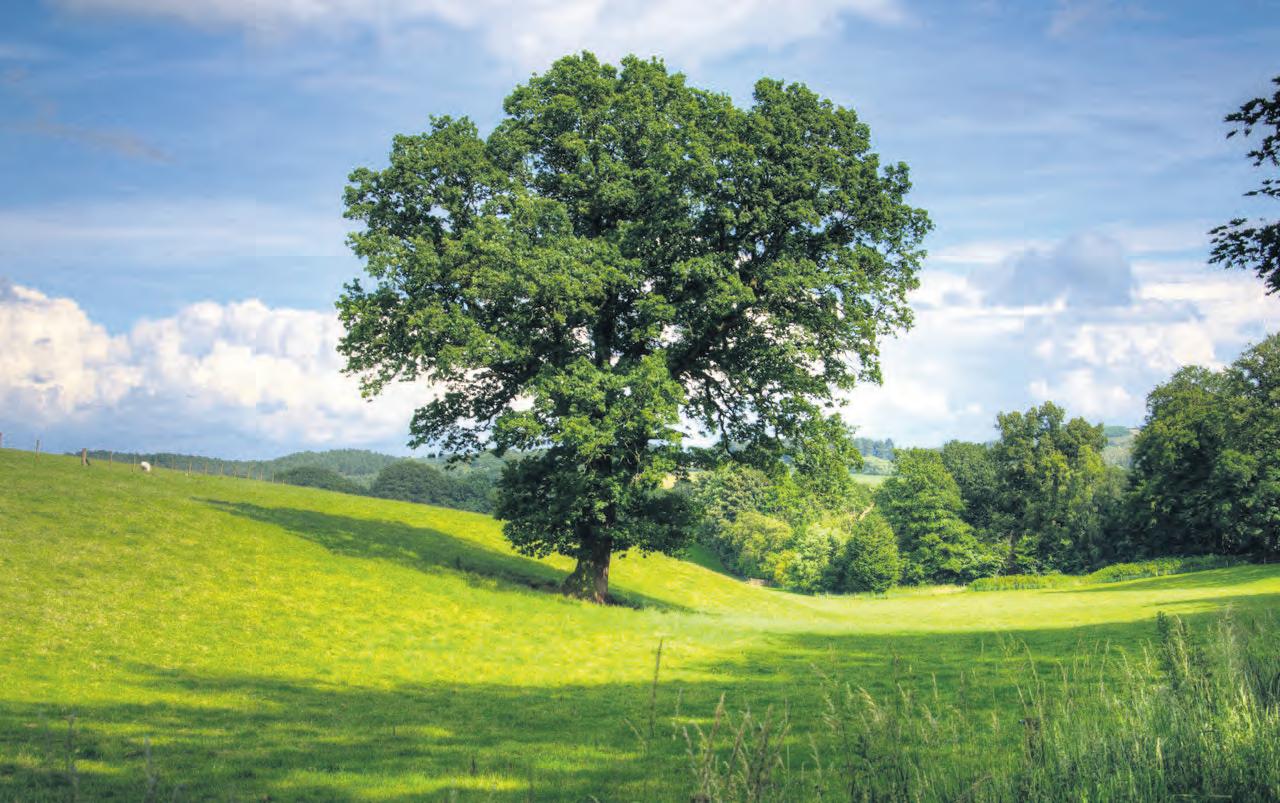
‘free tree inspections’, often with pictures of trees which have fallen on a car or a house in their advertisement. These people are trying to make you think such events are common and that you are at greater risk than you really are.
So, when they come and shake their heads and suck their teeth, you are easy prey. They then of course give you a price for the work.
If the same people came up to you shaking their head at your gleaming pride and joy sitting on the drive and said “Crikey mate, I wouldn’t get in that death trap if I were you”, you would think they were mad. Yet, whilst about five people are killed each year by falling trees and about 56 end up with injuries which require a trip to A&E, five people are killed on the roads every day, and 82 are seriously injured.
If you have a couple of grand to spend on your own safety, it would be far better spent on new tyres and brakes than on removing or mutilating a perfectly good tree. That is not to say that there is no risk from trees; there is a little bit. Unfortunately, you can spot a bald tyre, but you are not so confident in judging the condition of a tree.
So, take these thoughts with you: trees are self-optimising – this means they model themselves to suit the environment they live in.
Tall trees are adapted to be tall.
You wouldn’t ask some bloke that knocked on your door to ‘pimp up’ your motor and expect it to be safer than as the manufacturer specified it, so why do you think that some passing ‘erbert can improve on your tree which spent 320 million years evolving to stand safely in your garden?
Mark Hinsley, of Mark Hinsley Arboricultural Consultants Ltd, offering tree consultancy services. www.treeadvice.info
Ava Bench - Somerset & Hampshire ava@countrygardener.co.uk Tel: 01278 786139
Cath Pettyfer - Devon cath.pettyfer@countrygardener.co.uk Tel: 01837 82660
Corina Reay - Cotswolds & Dorset corina@countrygardener.co.uk Tel: 01823 410098
Classifieds classified@countrygardener.co.uk
Accounts and subscriptions Heather Rose heather@countrygardener.co.uk
Design & Production
Aidan Gill aidan@countrygardener.co.uk
Gemma Stringer gemma@countrygardener.co.uk
Distribution & Stockists distribution@countrygardener.co.uk


